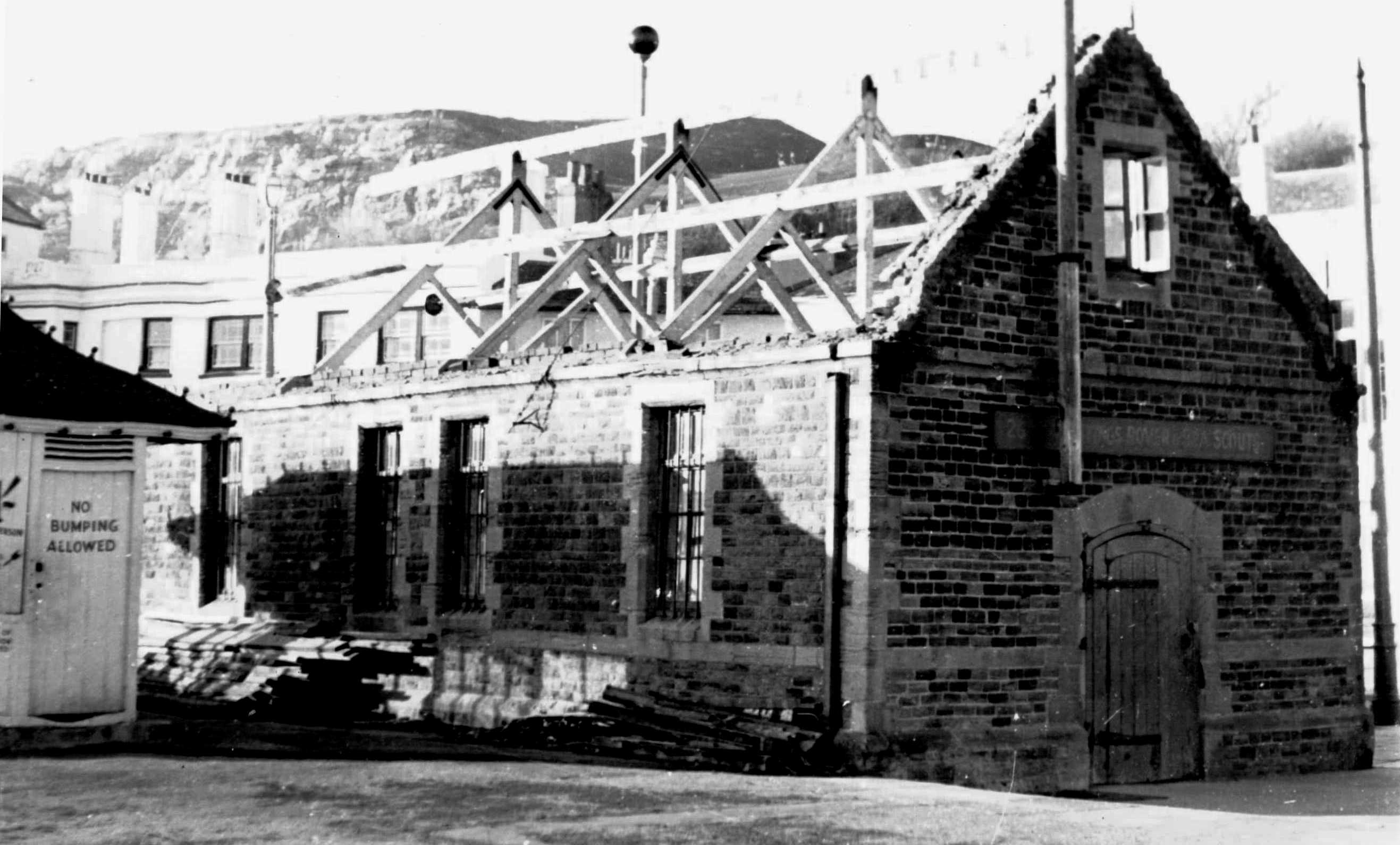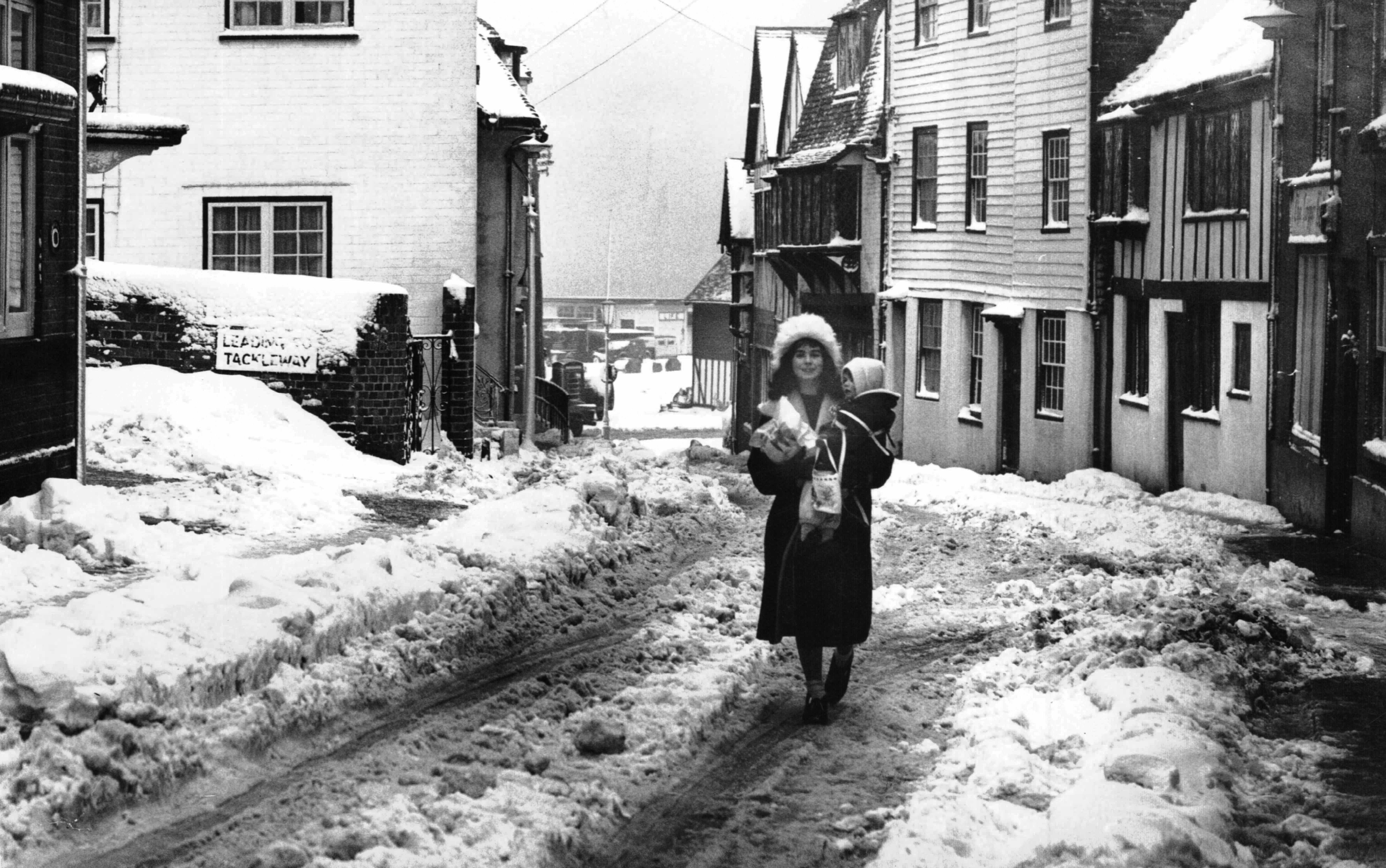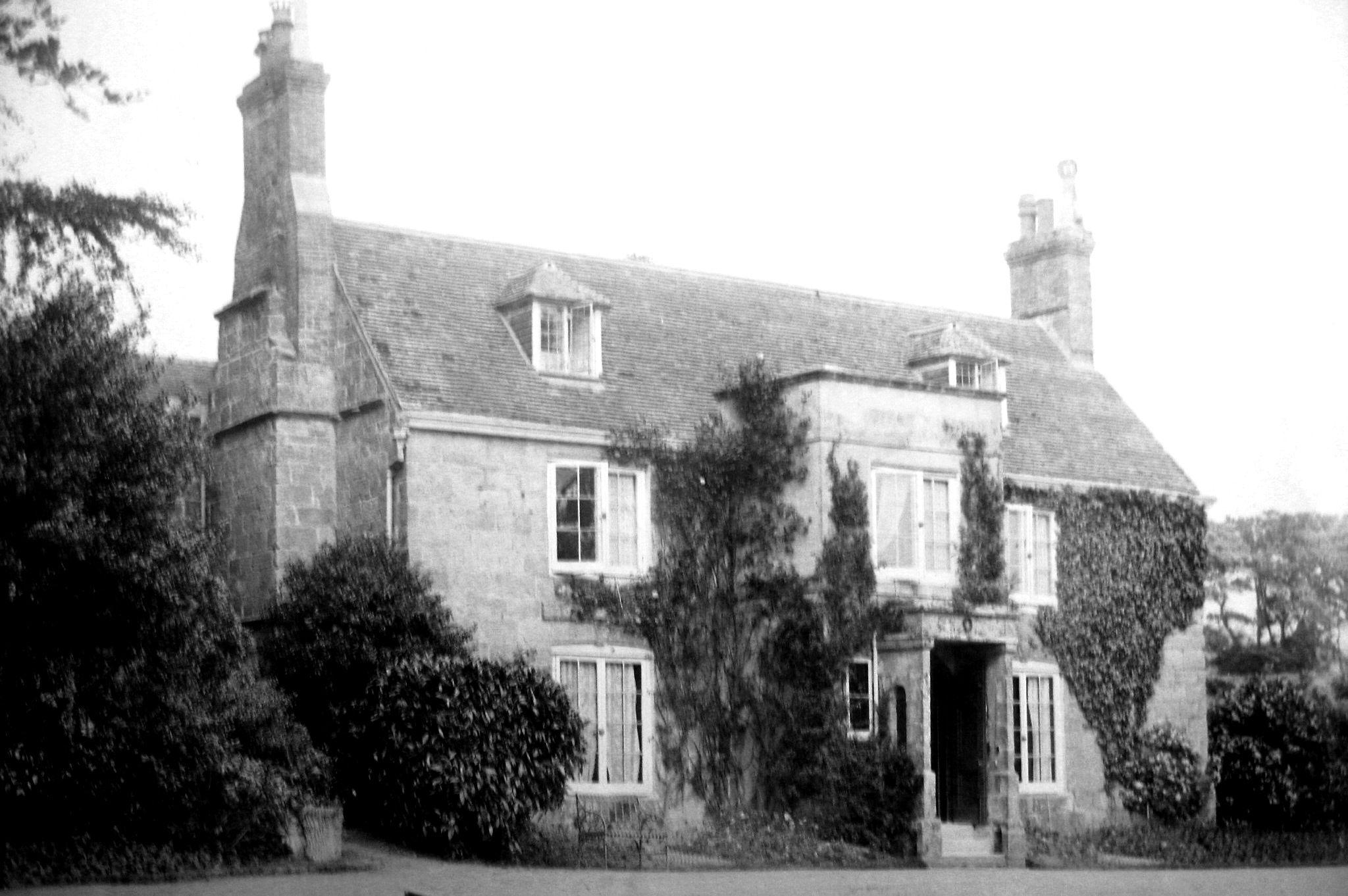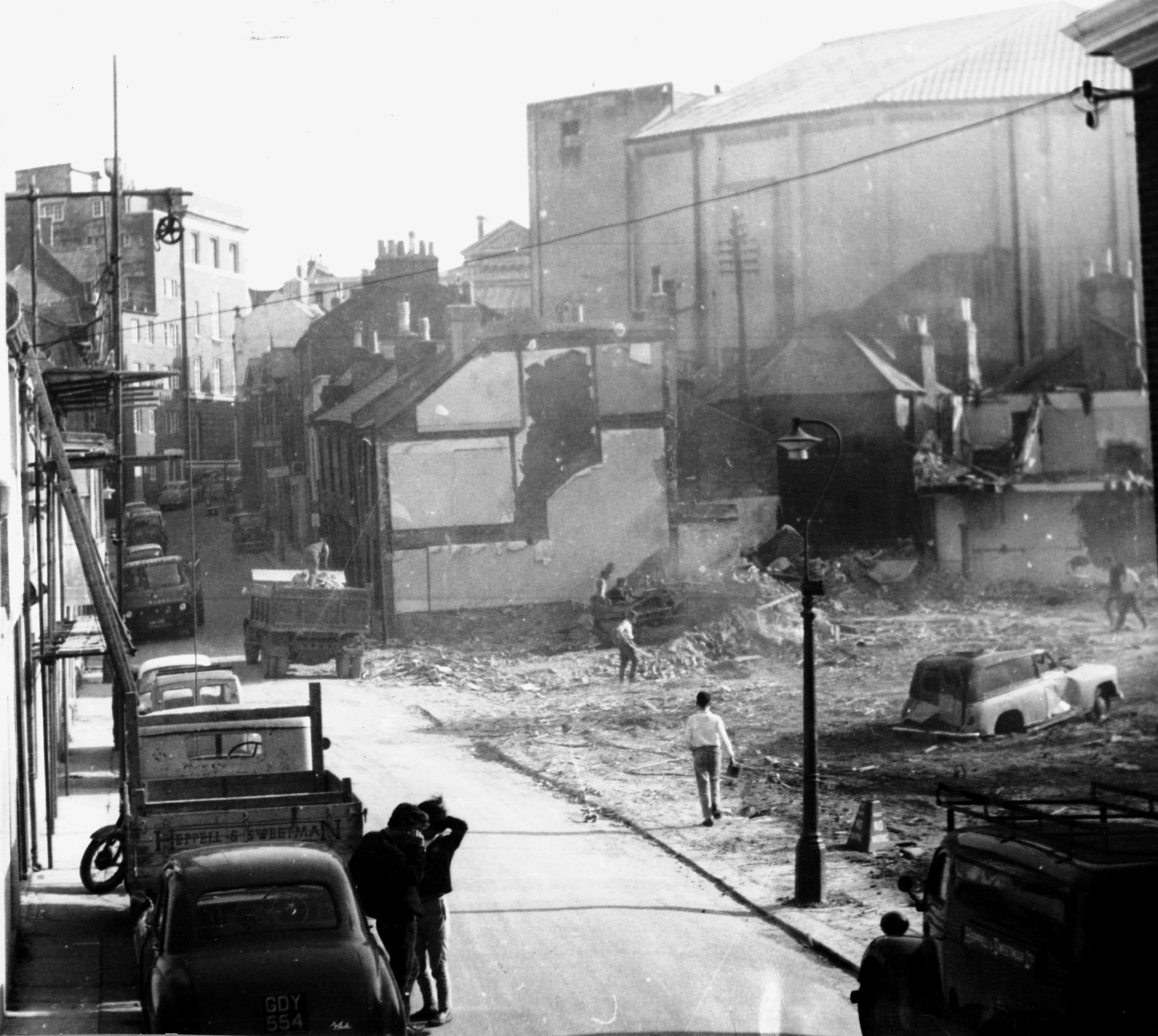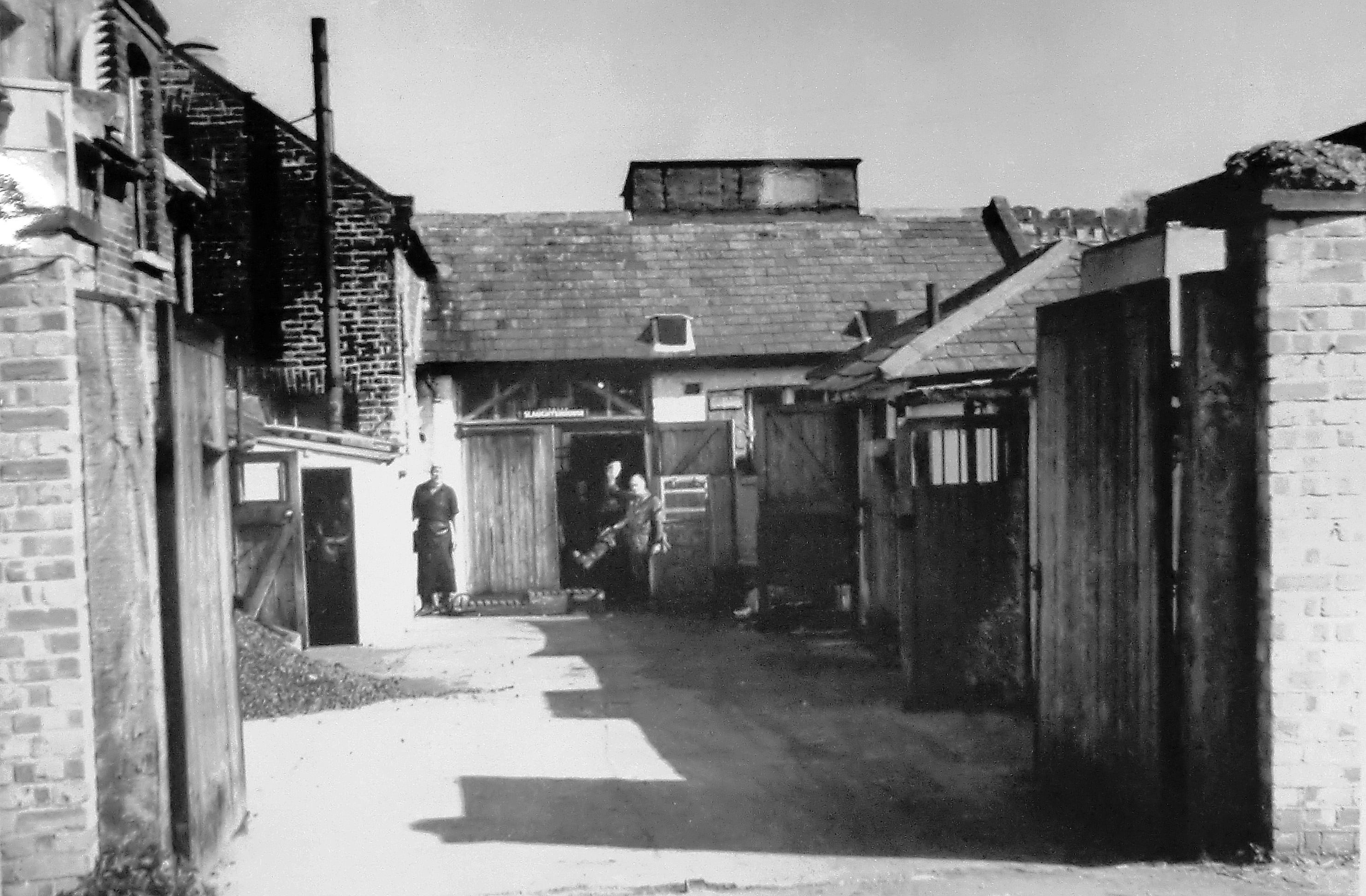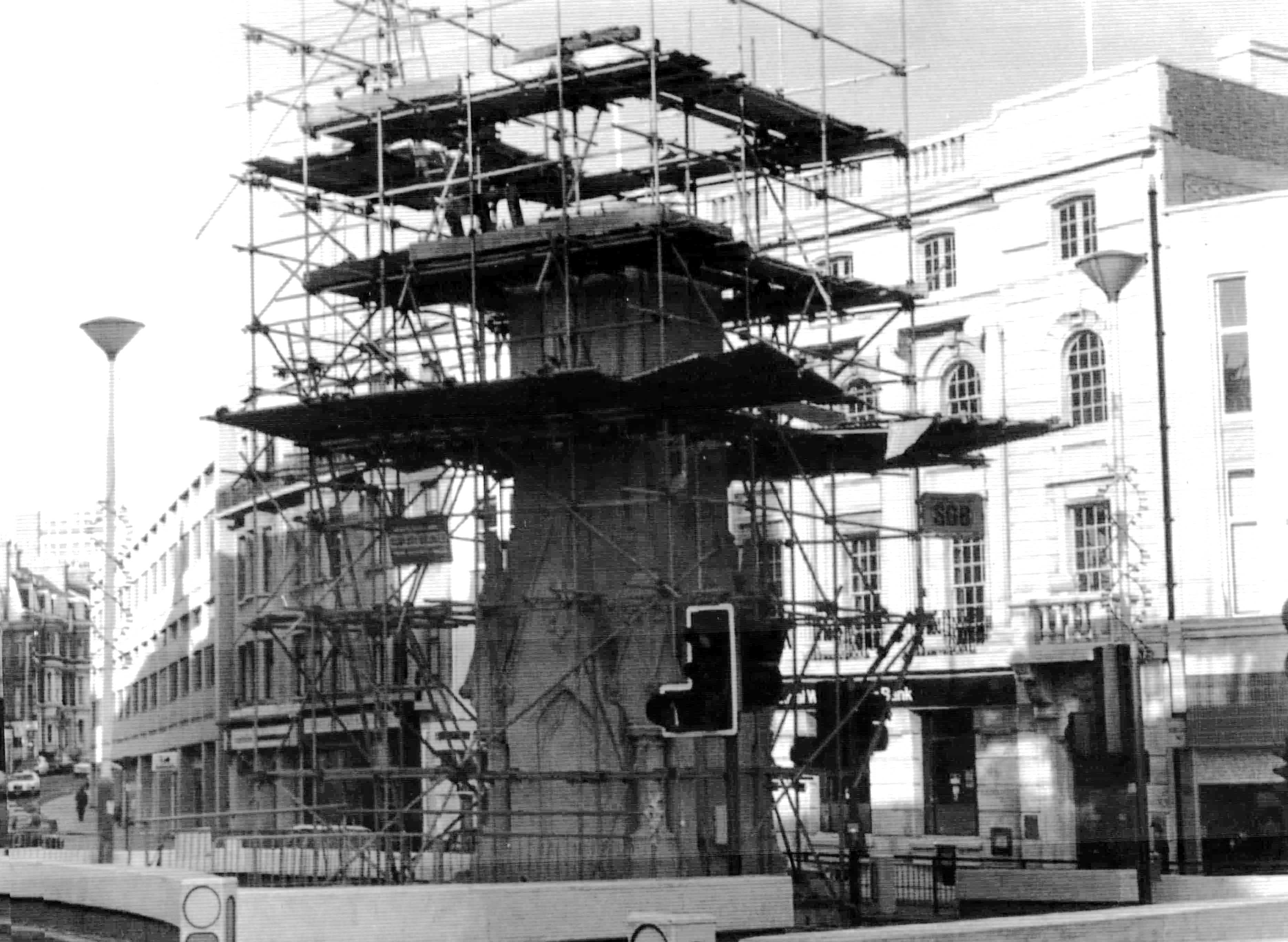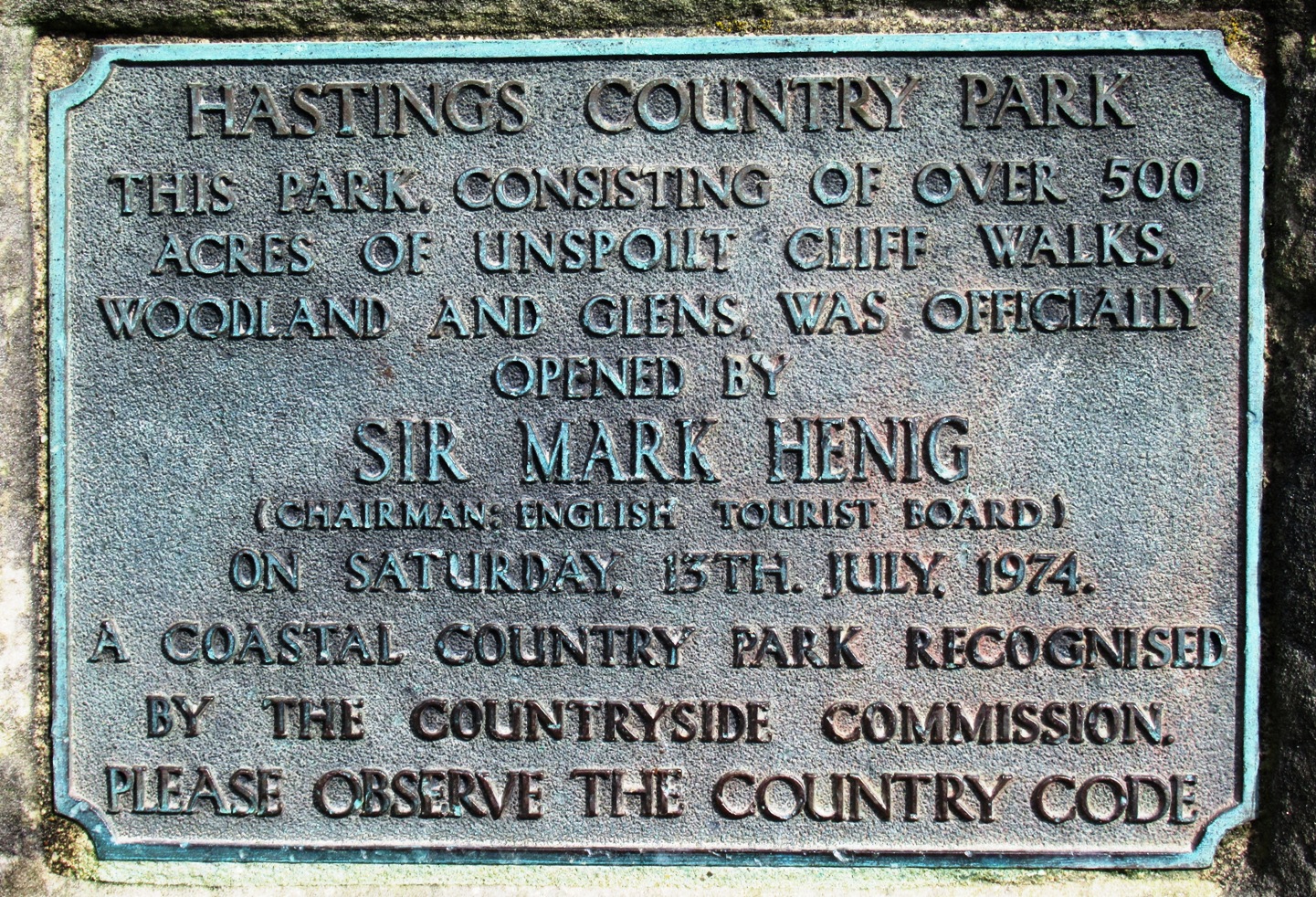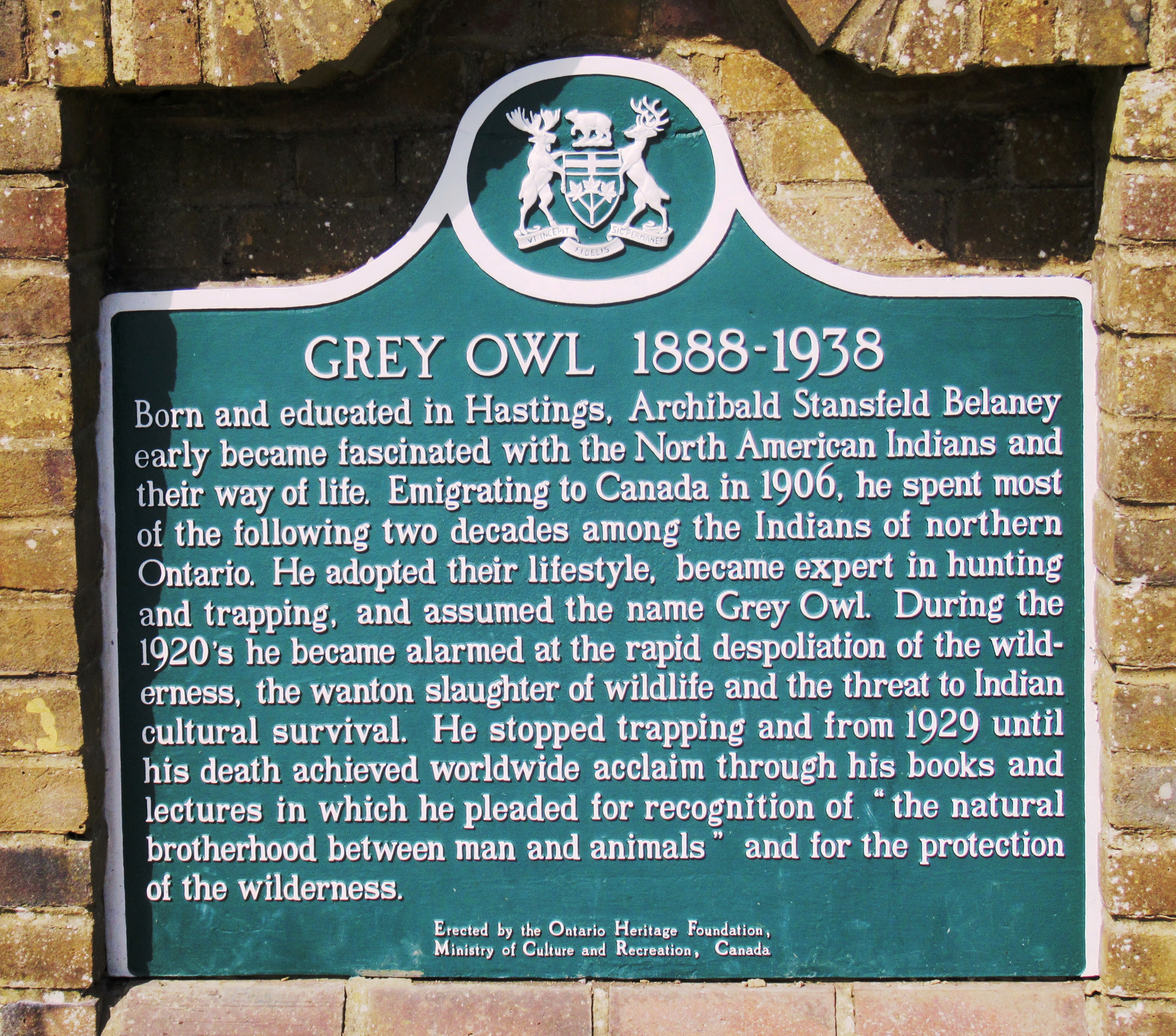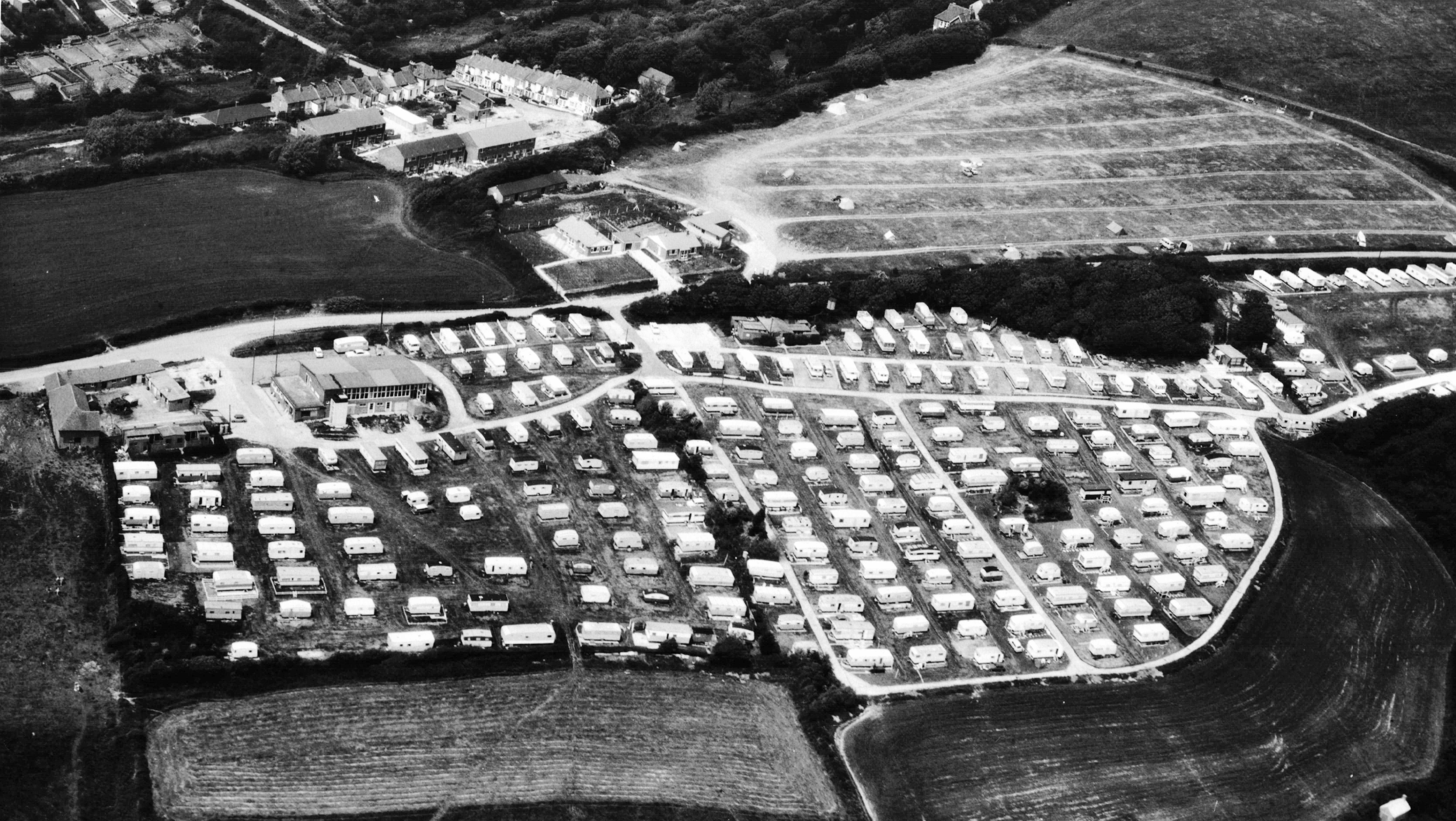1950-1979
1950 Feb - Neill Cooper-Key, the Tory MP for Hastings, won his seat again in the general election. He was Hastings MP from 1945 until succeeded by fellow Tory Kenneth Warren in 1970.
1950 Feb - There was a major landslide of the cliff between Marina and West Hill Road, St Leonards.
1950 March 19 - The new Hastings lifeboat, named MTC, took over from the 19-year old Cyril and Lilian Bishop. The MTC was named after the wartime Mechanised (or Motor) Transport Corps. She was self-righting, with two 18hp petrol engines, and a range of about 100 miles. She was on service until August 1964, being launched 56 times and saving 55 lives. The Cyril and Lilian Bishop passed through many hands after 1950, ending up in 1993 in the Evans Marine Boatyard on the River Yonne at Migennes, south-east of Paris, where she was looked after by the owner Simon Evans. On their own initiative, two Hastings men of local fishing families, DeeDay White and John ‘Tush’ Hamilton, purchased her from Mr Evans in 2016 and brought her back to Hastings (on a lorry) on Friday 1 July. Over the following months she was fully restored and then placed on permanent display at the junction of Harold Road and the Bourne.
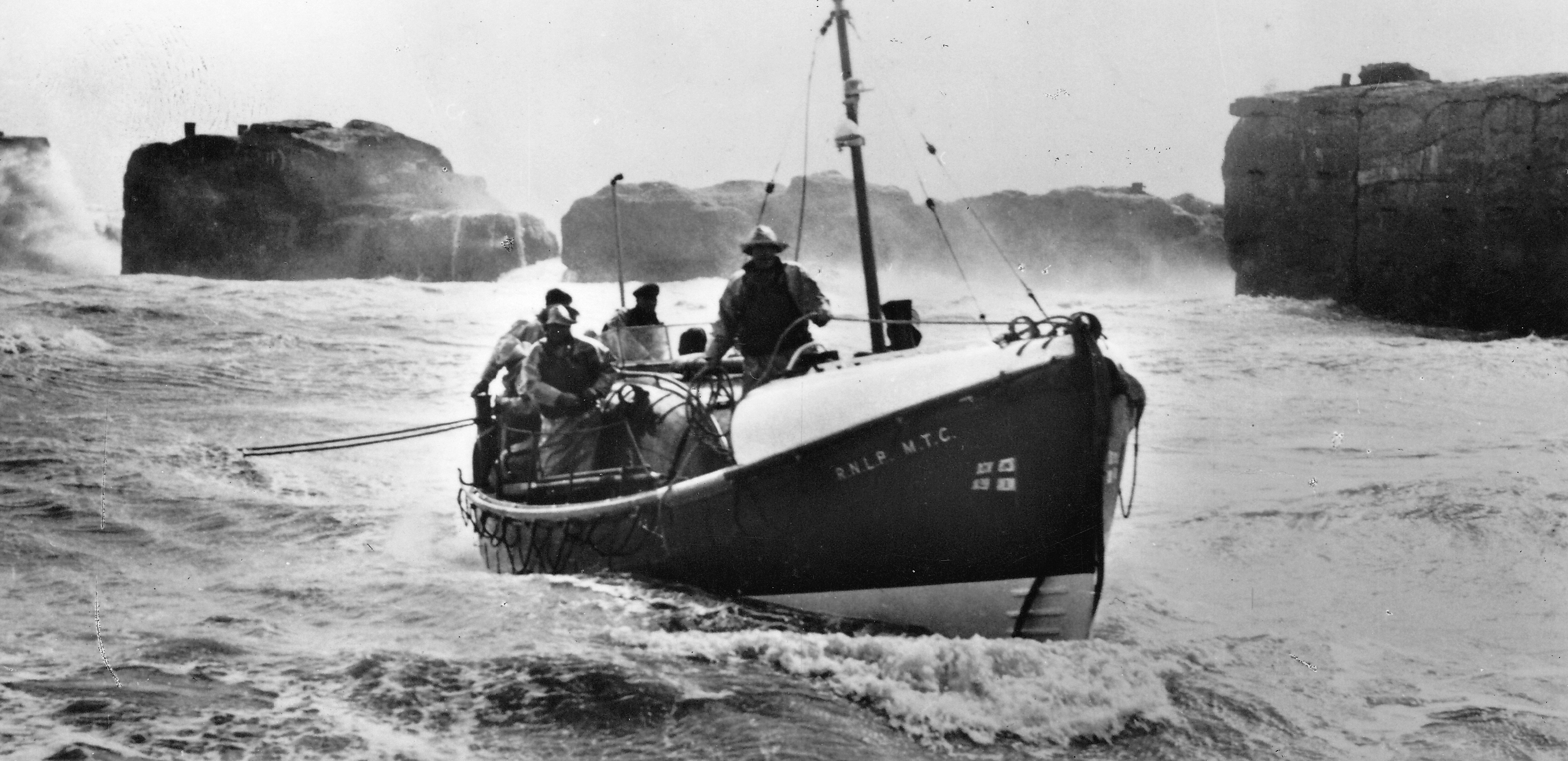
The MTC running ashore in a gale.
1950 June 5 - The Bopeep railway tunnel reopened after being closed for repairs since November 1949.
1950 Summer - A new bandstand was built at the Central Cricket Ground.
1950 Oct 23 - The large new water reservoir, Darwell, at Mountfield, was officially opened.
1950 Mid-Nov - A survey of the dilapidated harbour by Cyril Kirkpatrick said that it needed £334,000 spent on it, and the work would take three years. The report was not implemented.
1950 Dec - The Jenny Lind pub in the High Street re-opened, having been rebuilt since it was wrecked by a bomb on 23 May 1943. It was the first war-damaged building in the Old Town to be rebuilt. It became famous in 1959 when the British heavyweight boxing champion Don Cockell took the license.
1951 Jan - Hastings Council gave the Lannon brothers £1,000 for St Leonards Pier and began demolishing and clearing it. Most had been removed by mid-1952, with the last piles still in the seabed being removed with explosives in the summer of 1953.
1951 Jan 18 - Hastings Council bought 215 acres of Major Carlisle Sayer's estate, ie, Fairlight and Ecclesbourne Glens, part of Warren Glen, and all the cliff area from Ecclesbourne Glen stream to the start of the Firehills. The Council then owned all the 2.9 miles of cliff area between Tackleway and the east end of the Firehills, forming much of today's Hastings Country Park.
1951 Early - The Dust Destructor (refuse incinerator) at Rock-a-Nore was demolished.
The Rock-a-Nore Dust Destructor in 1910.
1951 April - Hastings Council decided to build 116 terraced houses at Hollington. In February 1952 102 council houses and 20 flats on the Harley Shute estate were approved by the Council.
1951 May 1 - The Hastings Permanent and the Isle of Thanet building societies merged to form the Hastings and Thanet Building Society, based at 29-31 Havelock Road.
1951 Summer - For one brief season, what claimed to be 'the world's smallest passenger-carrying tram' ran a daily service between the Bathing Pool and the west end of Marina, St Leonards. The 15-inch gauge ran on the promenade, but the service only ran for a year because of a petition by local residents complaining about its noise and the way it spoiled their view of the sea. It then relocated to Rhyl and five years later to Eastbourne.
1951 May 18 - Princess Elizabeth visited the town and took part in the ceremony of handing over the deeds of the castle (purchased by the Council in September 1949 for £3,500 from the Pelham family that had owned it since 1591), and the 215 acres of the glens and cliffs just bought Major Carlisle Sayer. She also laid the foundation stone of St Johns Church, Pevensey Road, Upper St Leonards, which was dedicated on 29 September 1952. The church had been bombed during the war.
1951 June 29 - Hastings Council gave planning permission 'in the national interest' for the RAF to erect 90-feet high lattice masts, six feet square, on two sites: the Fairlight Road radar station, and north of North’s Seat. In 1952 the Fairlight Road station was chosen to take part in the new anti-Soviet Rotor radar project, and it set up a technical centre on land adjoining the Fairlight Coastguard Station. A large underground bunker was built there, with a guardhouse on top. It came on line on 30 August 1952. It was redundant by 1956, but remained on care and maintenance until the early 1960s. It was sealed in 1973 and all buildings on site were demolished, although the underground bunker, with many rooms, still exists fairly intact.

The entrance to the underground bunker close to Fairlight Coastguard station.
1951 Nov 23 - The mayor opened the new main police station, at 4-5 Robertson Terrace. Until then it had been at the back of the town hall.
1952 April 28 - Opening of the new Elphinstone School in Parker Road.
1952 June 14 - The large Glasgow steamer Baron Douglas, carrying 7,000 tons of sugar, collided with a Yugoslav ship off Hastings and was run ashore at the Firehills to stop her sinking. Four days later three tugs and a salvage vessel towed her to Tilbury. The sugar, all lost or ruined, was the equivalent of one week’s ration for 31.4 million people.
1952 Aug 9 - The former Kinema Palace cinema in Norman Road re-opened as the Curzon, having been largely rebuilt. It closed in 1977.
1952 Autumn - Demolition of Coghurst Hall, the Brisco family seat.
1952 Nov - The Council-owned Ponswood area at Silverhill had been cleared and was ready to become an industrial estate.
1952 Nov 18 - The Old Hastings Preservation Society was launched at a meeting in the Old Town Hall Library in High Street. In 1955 a £30,000 'Appeal to Save Old Hastings' was launched, 'to restore and maintain the town's ancient houses and churches in their original setting'.
1953 March - The first post box in Hastings with 'ER II' on it is installed at the Mount Road sub-post office.
1953 April 20 - Opening of the new secondary modern school for girls at Ore (later called Hillcrest). The foundation stone had been laid in November 1950.
1953 April 21 - The new Hastings automatic telephone system started. The manual exchange at Baldslow was to close after 22 years service.
1953 June 2 - The coronation of Queen Elizabeth was widely celebrated throughout the town. 9,000 children were entertained in Alexandra Park and fishermen erected a tubular arch covered with nets across the road at the fishmarket.
1953 Oct - The statue of King Harold and Edith was moved from the Museum to Grosvenor Gardens.
1953 Oct 7 - The foundation stone of the new St Leonards Parish Church in Undercliff was laid by Princess Alice. Its predecessor on the same site was destroyed by a flying bomb on 29 July 1944. The nave and vestry were re-dedicated on 8 September 1956, the tower and baptistery on 29 July 1961.
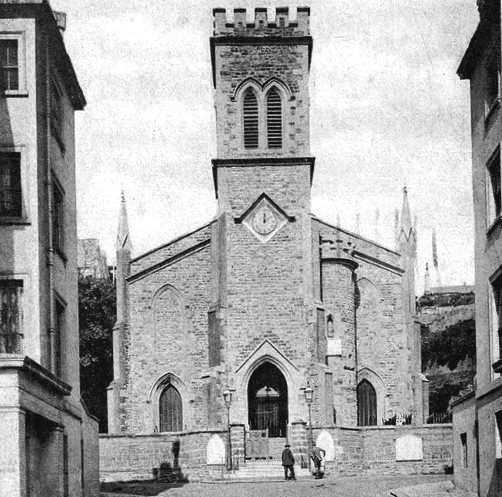
The St Leonards Parish Church that was destroyed by a bomb on 29 July 1944.
1954 March - Two pubs were to close: the Prince Albert in Rock-a-Rore Road and the Red Lion on the corner of Stone Street and Stonefield Road.
1954 March 24 - The new Silverdale School off Perth Road was officially declared open.
1954 July 1 - To meet a national regulation from July 1, all the town’s 29 zebra crossings had flashing yellow beacons installed (there had been 87 crossings, but Hastings Council did not like spending money on them, so it removed 58).
1954 July 29 - A ceremony was held at 62 Blackman Avenue, Hollington, to celebrate it being the 1,000th house built by Hastings Council since the war.
1955 Feb 19 - A new model village, designed by local personality Stan Deboo, opened in White Rock Gardens. It was forced to close in 1972 following major vandalism.
1955 Sept - The recently-retired prime minister Winston Churchill visited Hastings and took part in several events.
1955 Late Sept - The Royal Victoria Hotel was sold to Trust Houses Ltd.
1955 Oct 3 - The crematorium at the borough cemetery was officially opened by the Earl of Verulam. The first cremation took place on 1 November: Alice CC Jones, an 83-year old widow, of Blacklands Drive.
1955 Dec 7 - The new operating theatre at St Helens Hospital, Frederick Road, was opened by Sir Max Page.
1956 Jan - The Bomb Disposal Unit of the Royal Engineers began a three-year clearing of the minefield on, and near, the beach at the bottom of Fairlight Glen.
1956 Jan - Hastings Council agreed a major £400,000 clearance scheme at Halton, replacing many private houses with blocks of council flats, despite the opposition of the residents. Demolition took place in 1958-59. The flats were built 1960-61.
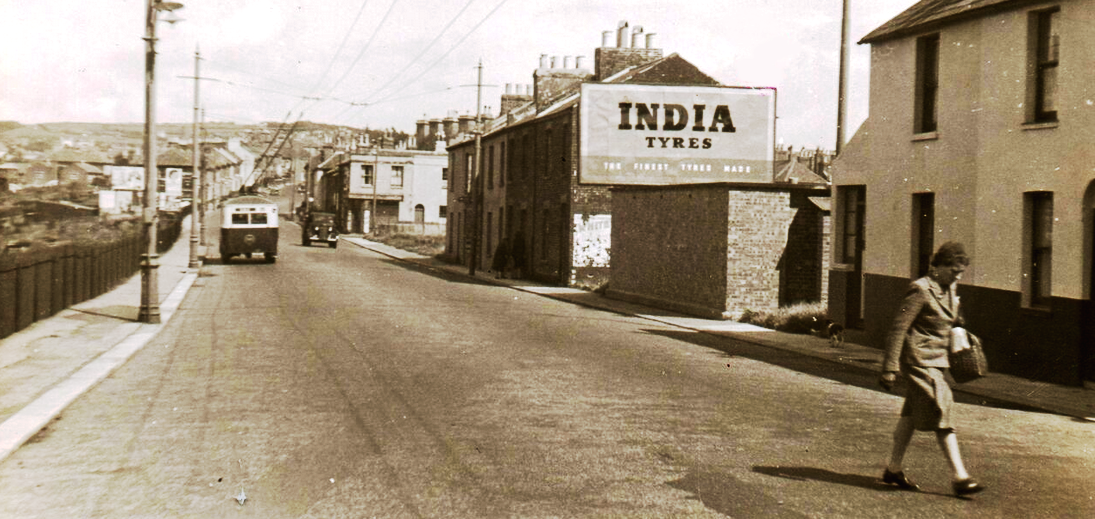
Halton in 1952, looking along Priory Road.
1956 March 26 - The new fishmarket opened, amongst the net shops. Its predecessor (demolished early 1956) had stood opposite the bottom of the High Street. Work had started in late November 1954.
1956 May - The army's bomb disposal unit began clearing the wartime minefield at the biottom of Fairlight Glen. The work took until November 1958.
1956 May 17 - The Fishermen’s Museum, in Rock-a-Nore Road, was declared open. For the full stoty of the Museum, see the feature on this website.
![]()
The Fishermen's Museum in the late 1950s.
1956 Late May - The Arthur Blackman health clinic at Hollington was opened by the Duke of Norfolk.
1956 Dec 15 - Fairlight School closed.
1957 Jan - The Minister of Housing and Local Government put a ban on the development of the unspoilt area of St Helens Park Estate, which became known as St Helens Woods.
1957 Early March - Hastings Council decided to give up the St Leonards Golf Club, despite protests from members.
1957 March 26 - The mayor opened the new Royston Carr & Co's shirt factory on the Ponswood estate.
1957 June - The first diesel trains were introduced on the Hastings-Charing Cross line, gradually replacing steam over the next 12 months. The first diesel had arrived on 23 February 1957. They took over formally on Monday 9 June 1958, replacing the Schools-class locos that had been running the service since 1931. A very large new railway carriage shed was built at Bulverhythe to service the diesels.
1957 July 31 - The parliamentary bill to abolish the Hastings trolley bus system becomes law, despite widespread local opposition. The trolley buses had taken over from the trams in 1928.
1957 Nov 4 - A severe gale caused major damage to Hastings Pier's main pavilion, which had to close for three months.
1957-58 - Four-storey blocks of flats were built by Hastings Council as the Down Farm Estate, Ore. These were for people rehoused following the slum clearance at Halton and elsewhere. The roads were named after distant landmarks visible from the building site.
1958 - The Hastings Downs Golf Club closed, having been based at Fishponds Farm in Barley Lane since 1924. The closure followed the decision in April 1958 by Hastings Council not to continue subsidising the club, and not to pay Major Carlisle Sayer the £20,000 he was seeking if the council insisted on purchasing it. Instead, the councillors decided to end years of debate over its future and try to buy the town’s other course, in Filsham Valley.
1958 Jan - The Old Hastings Preservation Society unsuccessfully campaigned to stop the demolition of the historic old Customs House at 85-86 High Street, next to Sinnock Square. Two months later Hastings Council gave the Society a grant of £3,250 towards the cost of restoring Pelham Crescent. After more fund-raising, work started there in September 1959.
1958 Late March - Hastings Council rejected a plan to turn the West St Leonards Bathing Pool into a caravan hotel.
1958 June - The Minister of Transport gave the go-ahead for building the main road through the Old Town, the 1930s plan which had been held up by the war. The first section of The Bourne, from the seafront to the newly built Roebuck Street, was finished by early 1959. Work started on the second section, north from Roebuck Street, in mid-1962 and was finished about a year later.
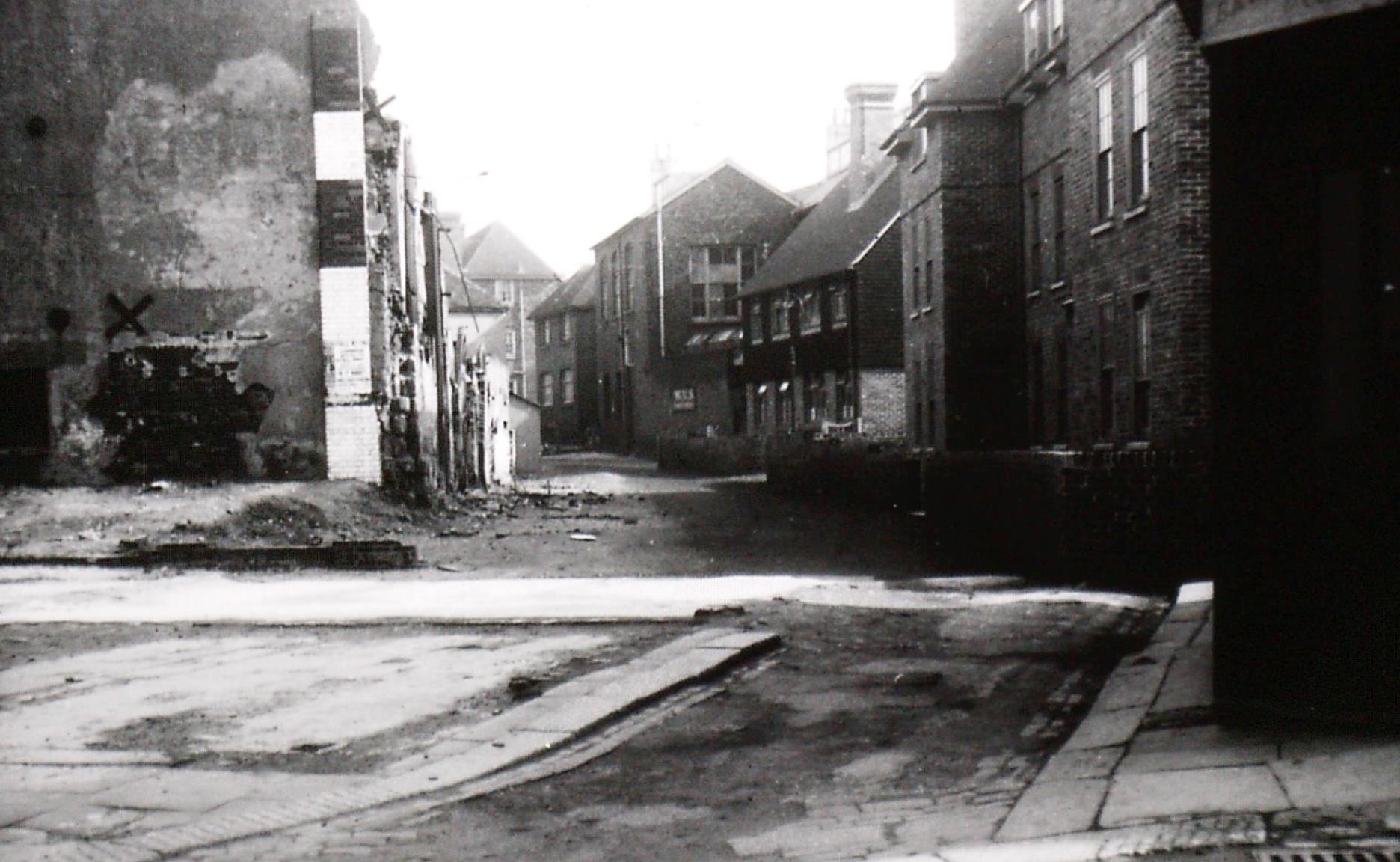
Clearing through the Old Town to build the Bourne. From Courthouse Street, looking north.
1958 Nov - The Royal Engineers completed their clearing of war-time mines from the bottom of Fairlight Glen, a project which began in early 1956 and involved cutting a roadway down the glen.
1958-59 - A line of 23 shops was built on the Queens Road side of the Cricket Ground, with seating above them facing onto the pitch.
1959 - Elva Engineering built a racing car factory in Sedlescombe Road North, opposite Ashdown House.
1959 Jan - Work was well under way in the Halton clearance scheme. 89 houses were soon to be demolished.
1959 April - Work began on demolishing all the buildings at the east end of Castle Street and redeveloping the site. A roundabout with an illuminated fountain (still there) was constructed early on, and on 4 June 1960 the mayor ceremonially switched on its lighting. By February 1961 work had largely finished on the three-storey building with flats and shops (including Argos).

Building the roundabout in 1959.
1959 Jan 22 - Don Cockell, former light heavyweight boxing champion of Great Britain, gave up being the licensee of the Jenny Lind pub in the High Street, after several months in the position. He later became a pig farmer at Pevensey.
1959 Feb 2 - The tiny Snailham Halt on the Hastings-Ashford railway line closed. It was between Doleham Halt and Winchelsea.
1959 May 31 - This was the last day of the trolleybus service, after 31 years in operation. Diesel buses took over from June 1. There had been 54 years of electric traction in Hastings, from the start of trams in 1905. The service had been run since 1935 by the Maidstone and District bus company, but in August 1958 it had announced that the trolleybuses were going to be replaced in 1959 by new Atlantean buses, despite much local opposition.
1959 June 16 - What had been the semi-derelict old stables at the top of the High Street were re-opened as the Stables Theatre by Sir Ralph Richardson. The manager James Webster resigned four weeks later. The stables had been built in 1746 by John Collier, then the most powerful man in the town, for his residence, Old Hastings House, across the road. The stables remained in the Collier/Milward family until sold in 1932 to Hastings Council as a garage for the mayor’s limousine. By the early 1950s the building was nearly derelict. In 1955 the Old Hastings Preservation Society began a campaign to save the building, and work began on 1 February 1958. Until 1978 the entrance was in the High Street, but then a large extension and new entrance were built on the Bourne side.
1959 July 16 - The former town hall in the High Street, which had been both a museum and library since March 1949, re-opened as the Museum of Local History, on both floors.
1959 Sept - Work started on restoring all of Pelham Crescent.
1959 Sept 10-11 - Eighty acres of Warren Glen were destroyed in the town’s biggest fire since 1929. It was caused by a Coastguard maroon falling into the extensive gorse, a false alarm call-out of its rescue team.
1959 Dec - The old Lifeboat House opposite the Cutter pub was demolished. The seafront there was widened later, linking in with the completion of The Bourne road through the Old Town in 1963.
The 1882 lifeboat house being demolished.
1960 June 4 - The mayor set in motion the illuminated fountain on the new traffic roundabout at Breeds Place.
1960 Early Nov - Heavy rain and gales combined with high tides brought severe flooding. West St Leonards was described as 'Little Venice'.
1960 Dec 18 - A landslip carried away the cliff on which the Lovers Seat stone stood, although the ‘seat’ itself survived until slipping over the edge in early February 1961. A crane pulled it back up. The seat is now resting next to a nearby path.
1961 Early Jan - There was an extensive cliff fall at Ecclesbourne Glen following heavy rain.
1961 April - A wildlife sanctuary was being created at Fairlight following an anonymous donor’s gift of Mallydams Wood.
1961 April - The 45-year old bandstand on the parade extension of Hastings Pier was found to be in a dilapidated condition, so it was removed in May, and in June was replaced by a new moveable bandstand.
1961 June 24 - A fire destroyed four net shops in Rock-a-Nore Road and badly damaged a fifth, in rows T and U. Hastings Council replaced the four early in 1962. The fire awakened public concern about the future of all the net shops, many of which looked abandoned.
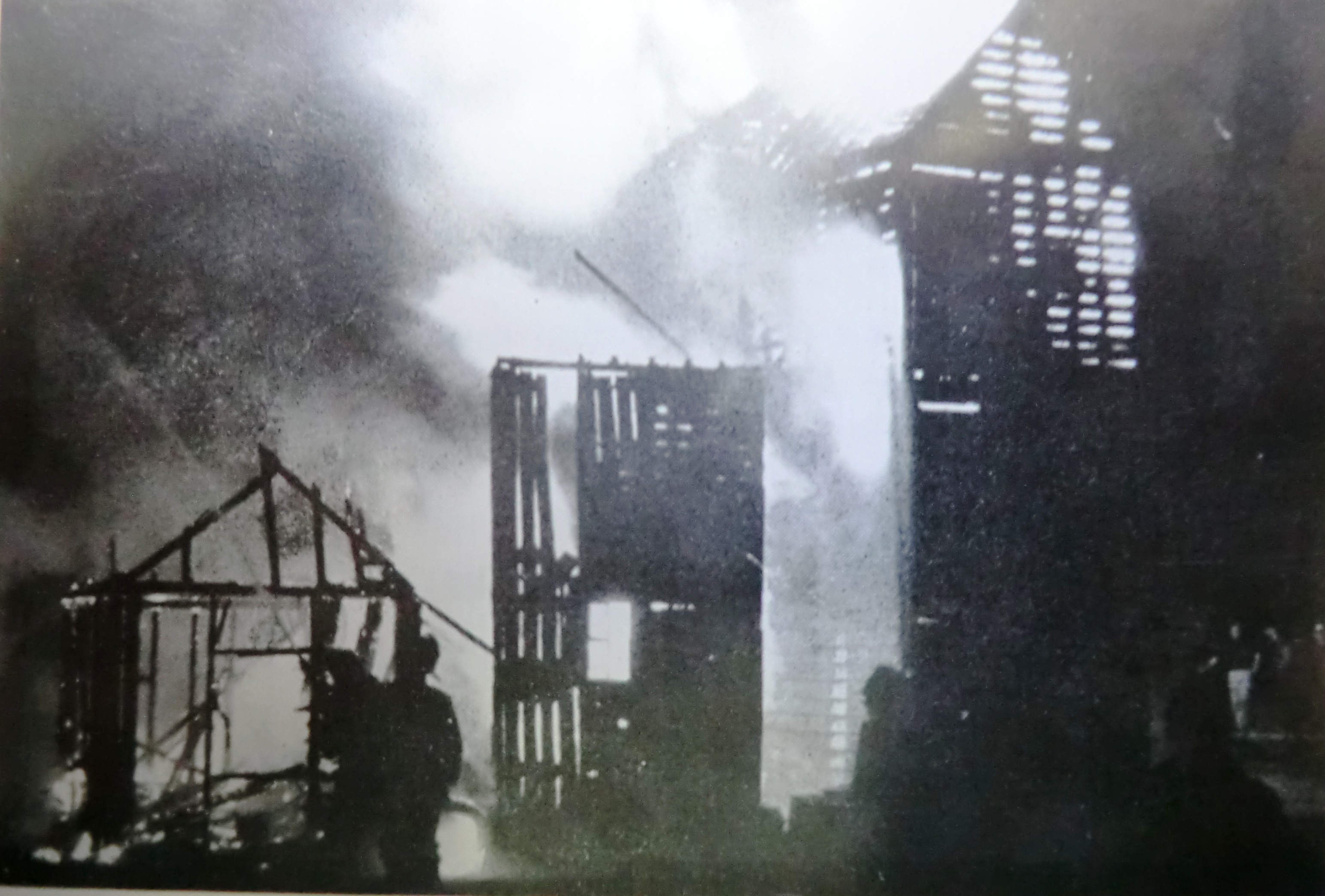
The four net shops on fire.
1961 Sept - Opening of an ugly large tower block, built as part of Hastings College, in Archery Road.
1962 Feb - The new St Leonards Church was completed. It replaced the church that had been destroyed by a bomb during the war.
1962 Early March - It was agreed to build a new community centre for the West Hill, on the corner of Croft Road and Bembrook. Cliff Richards drew big crowds at the Ritz Cinema, and again at the ABC Cinema in Cambridge Road in March 1963.

The former Coastguard station at Ecclesbourne in 1960.
1962 Oct - Hastings Council accepted a £350 tender to demolish the Ecclesbourne Coastguard Station and push it over the cliff. It is believed that the last person to live there left at the end of the summer of 1963. There was still no piped water (it came from the well in the yard) and the southern building was only inches from the edge of the cliff.
1962 Dec 26 - Prolonged snowfall started arctic weather lasting into March, the coldest and longest severe winter for many years. Nine year-old Geoffrey Corder of Godwin Road died after falling through the ice on the upper Clive Vale reservoir at about 4pm on December 26. Other youngsters with him (including the author of this Chronicle) unsuccessfully tried to save him. By early January there were 10 feet high snow drifts on the Ridge. A floating ice pack was seen in Rye Bay in late January. There was still some snow on the ground in sheltered places in late March.
Shopping in All Saints Street after the blizzard.
1963 - The Bourne (the new road through the Old Town) was completed.
1963 May - Hastings Council announced it had bought 450 acres of land comprising Fairlight Place and its farm (much of the inland part of today’s Country Park) for £90,000 from Major Alfred Carlisle Sayer. This was one of the biggest land purchases in the history of the borough. In 1951 the Major had semi-donated to the Council 215 acres comprising Fairlight and Ecclesbourne Glens and the clifftop walks. He died 19 December 1964, aged 78. The Observer said he was 'one of the town’s great benefactors'. He sold the farm to the Council because he was 'concerned in case the land fell into the hands of speculative developers and felt that it was in the best interests of the town that it should control this land'.
Fairlight Place.
1963 June - The 11 caves at Rock-a-Nore were sprayed with an extremely strong-smelling chemical up by Hastings Council to stop 'beatniks' living in them. About 17 young people had recently been found sleeping in the caves, three of them suffering from scabies. Parties of beatnicks had been seen arriving at the caves with large amounts of luggage. The caves were sprayed again in mid-1964.
1963 June 6 - The Hastings fishing boat Florence Harffey RX 100 caught a 500 pound wartime bomb in its nets. It was safely exploded three-quarters of a mile out to sea, although some houses in the Old Town shook.
1963 July 11 - A double gas explosion injured 30 people and destroyed and damaged several buildings in Marine Parade.
1963 Sept - Clearance began of most of the properties in Priory Street. Hastings Council gave a mining lease for the 51 acres of land near Fairlight Church just purchased from Major Sayer to Messrs Cole and Jennings for sand quarrying.
Priory Street being cleared. The big building is the ABC Cinema in Cambridge Road.
1964 May - Hastings lifeboat station started using its first inshore inflatable rescue boat, named Mermaid, designed to cope with the rapidly increasing number of emergencies involving bathers and small boats close inshore, often in fine weather. She had two crew, was 14 feet long and had a 40hp outboard engine.
1964 June - The railway line connecting Crowhurst Station on the Hastings-Tunbridge Wells line with Sidley and Bexhill closed. The massive 17-arch viaduct over the Crowhurst marshes was demolished in 1969.
1964 June - A large new telephone exchange was to be built at the bottom of Havelock Road, it was announced. This would involve the demolition of many buildings. Work started late 1968 but took until April 1974 because of the need to drill piles 75 feet through the underlying shingle. Today it is the University Centre Hastings.
1964 Aug 3 - Thousands of mods and rockers took over the town on Bank Holiday Monday, but the police manage to keep control. This followed an appearance by the Rolling Stones on the pier on Saturday 1 August, and climaxed on the Monday.
1964 Aug 29 - The new Hastings offshore lifeboat, named Fairlight, came into service, replacing the 14-year old MTC. She was one of the new Oakley-class of boats, 37 feet long, with two 52hp diesel engines and a crew of eight. For the first time a tractor and carriage were used for launching a Hastings lifeboat. The tractor is now in the Lifeboat Museum section of the Chatham Historic Dockyard.
1964 Sept - The Grammar School moved from Nelson Road to new premises in Parkstone Road. In 1978 it was renamed the William Parker Comprehensive, after its 1619 benefactor.

The old Grammar School building being demolished in 1972.
1965 June 22 - Hastings Council approved a £765,000 scheme to build a new long sea sewage outfall at West St Leonards.
1965 Summer - The eyesore Regency Mansions, originally the Grand Hotel, at Verulam Place opposite the pier, were demolished. The site was left empty for many years.
1965 Oct 14 - William the Conqueror's reputed 'breakfast table' stone was unveiled at its new location on the parade extension, on this, the 899th anniversary of the Battle of Hastings.
1965 Nov 8 - The four new multi-storey tower blocks of flats on Stonehouse Drive, Hollington, the first and last of their type in the town, were officially opened.
1965 Early Dec - A man who killed his wife and two children whilst on holiday in Coghurst Caravan Park was jailed for life.
1965 Dec 12 - Fire gutted the Ponda Puzzle Works in Battle Road, putting 60 people out of work.

Breeds Place and Pelham Crescent in the 1920s.
1966 - Breeds Place, a striking six storey terrace, built in 1828 as an extension of Pelham Crescent, was demolished. It had brought a major upgrade of the town as an attractive seaside resort in 1828. It was built by landowner James Lansdell, who named it after his new wife Miss Martha Breeds, a member of the influential Breeds family. Around 1960 the hotel and flats at Nos 1-6 Breeds Place were bought by a speculator and the occupants moved out. For the next five years they were all empty and became increasingly derelict while Hastings Council discussed rival planning applications for their demolition. Then in late 1965 the Council gave permission for a six-storey office block, with shops on the ground floor. Demolition began quickly and the new block was up and running by early 1967. The block was initially called Arbuthnot House, as it was occupied by merchant bankers Arbuthnot Factors. Amongst the early shops were the Employment Offices of the Department of Employment, which in August 1973 became the first ‘Jobcentre’ in Sussex. Later the building was renamed Aquila House, and in 1988 Barclays Bank took over Arbuthnot Factors.
1966 Jan - More than two years after a public inquiry held in September 1963, local residents around the Pinders/Tile Kiln area of north Clive Vale heard that they have been largely successful in stopping development there.
1966 Early - The former RAF domestic camp in Fairlight Road, with about 40 huts and a water tower, was cleared. The RAF had leased this land in 1940 as the base for radar surveillance here and close to Fairlight Coastguard station. Today it is the picnic site (also known as the Helipad).
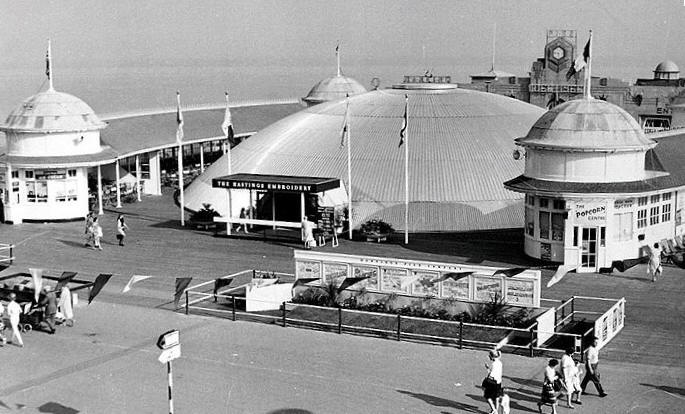
The pier and its new Triodome in 1966.
1966 May 24 - The Triodome opened on Hastings Pier. It was a large domed and circular exhibition hall on the parade extension, housing the 247 feet long Hastings Embroidery, which had been made to celebrate the 900th anniversary of the Battle of Hastings on 14 October 1966. The Triodome took over the space used since 1961 by the moveable bandstand, which was moved to Warrior Square gardens. The Queen visited the Embroidery on 28 October. The Triodome cost about £12,000 and from 1967 was used for a variety of amusements. It is now on Brighton Pier.
1966 June - The town’s last windmill, Draper’s Mill, at Silverhill, was demolished because of its poor condition. It was built in 1866 and was last used in 1941.
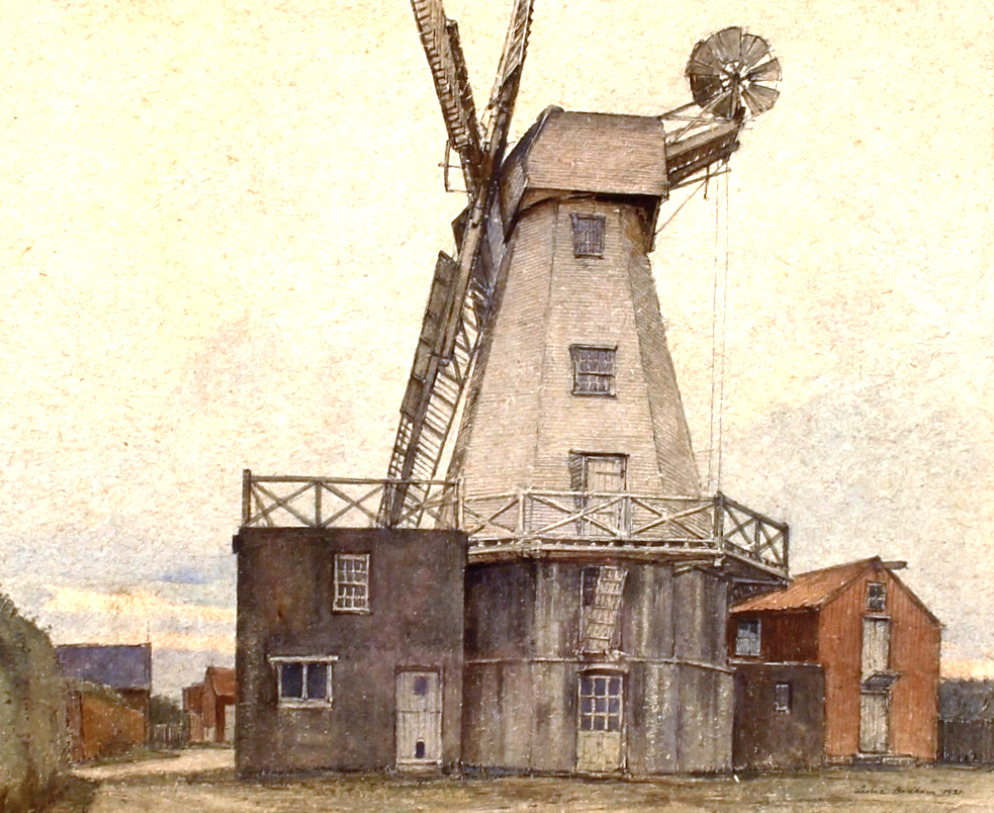
The Silverhill windmill in 1931.
1966 Aug - Summerfields School, Bohemia Road, closed as a private prep school following the purchase of the 47 acre Brisco estate by Hastings Council. Its contents were auctioned on 6 August 1966. Over the following years, the estate (from the Museum to St Pauls Road) was redeveloped as a ‘civic centre complex’, with police, fire and ambulance stations, law courts, a sports centre and some Council offices. The school was used as an extension of Tower Road School until mid-1972, and it was demolished early in 1973.
1966 Late Aug - The hovercraft that had been running pleasure trips off Hastings beach broke down on the sea and had to be rescued by the lifeboat.
1966 Autumn - Council houses were being built up Harrow Lane.
1966 Oct 14 - To mark the 900th anniversary of the Battle of Hastings, there were many celebrations over the weekend of 15-16th, including a re-enactment of the battle in the fields at Battle Abbey. On October 28 the Queen and the Duke of Edinburgh visited the town, viewing the pier's Triodome and unveiling the plaque for the newly-built College of Further Education in Archery Road. From August to December there was much vandalism in the town, consisting of slogans painted in French on many buildings and graves.
1966 Nov - The famous old Castle Hotel in Wellington Square, built 1818, was to be demolished and replaced by a Tesco supermarket, it was announced.
1966 Dec - The Bourne Street Baths and Washhouse were to close, decided Hastings Council. They had opened in June 1865 and had played a valuable role in both improving public health in the Old Town and enabling fishermen's wives to set up laundry businesses, as a supplement to their husbands unreliable fisheries income. In 1965-66 the baths had been used 3,237 times, and the laundry 1,968 times. But the boiler and washing machine were both in poor condition, while a lundrette had recently opened in the High Street and there were public baths at White Rock.
1967 Early - Three doctors bought the old Roebuck Inn and the adjoining 26 High Street, to build Roebuck Surgery on the site.
1967 May - The Gaiety Cinema in Queens Road was redecorated and renamed the Classic.
1967 Early May - St Helens Wood was officially opened to the public, having been donated to the public by Miss Isabel Blackman, who had just been designated as the first woman honorary freeman of the borough.
1967 July 9 - The West Marina Railway Station, on the Brighton line just west of Bopeep tunnel, closed.
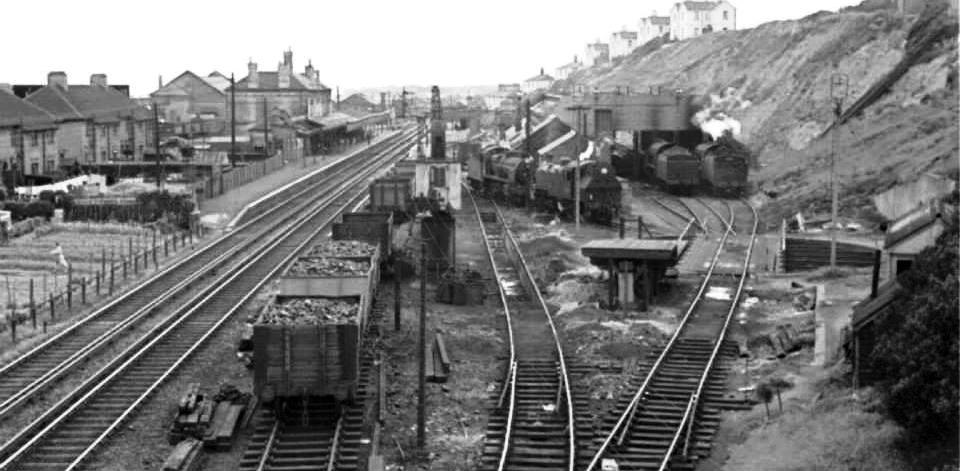
West Marina Station in 1956.
1967 Late Aug - Six thousand youngsters attended the music festival held at the Pilot Field in Elphinstone Road, prompting many complaints from local residents about the behaviour of the 'flower people'.
1967 Sept - The Burton’s St Leonards Society was set up to try to stop more of the original St Leonards being lost to development.
1967 Nov 5 - Six Hastings people were killed and many injured in the Hither Green railway disaster, involving a Hastings-Charing Cross train.
1967 Late - Work started on building the Heron House office block in London Road for the Department of Health and Social Security. It was on the site of the old abattoir.
The abbatoir that stood on the site of Heron House in London Road.
1968 Jan 1 - Hastings Borough Police Force merged with four other forces to become the new Sussex Police Force.
1968 March - The Minister of Transport, Barbara Castle, rejected plans to close the Hastings-Ashford railway line.
1968 Sept - The town’s first automatically controlled car park opened, in Cross Street, central St Leonards. The parker bought a ticket from a machine and displayed it. Two hours cost a shilling (5p).
1968 Oct - Hastings Council and the GLC agreed a long-term Town Expansion Scheme, whereby more than 18,000 Londoners would be despatched to Hastings by 1981, along with commercial and industrial premises for them to work in. Unfortunately, the people arrived but the jobs did not. Hollington was expanded to the north-west, creating a future big estate of council houses with many unemployed tenants.
1969 April - Glyne Gap gasworks closed.
1969 Mid-May - The new multi-storey car park in Priory Street was opened.
1969 June - The magnificent 17-arch railway viaduct across the Combe Haven stream was blown up. It was part of the line linking Crowhurst to Bexhill which opened in 1902, but was axed by Beeching in 1964. West Marina Station was demolished at this time.
1969 June 10 - Hastings Council agreed a municipal golf course and clubhouse could be built on 200 acres of Beauport Park, despite the extremely high cost of at least £154,000. Clearance for the 18-hole course began in April 1970. It was officially opened on 1 July 1973. In later years it became known as the ‘real town hall’ of Hastings, where significant decisions were made by members of the local establishment out of the public eye. The Cooden Beach Hotel was seen as the 'real town hall' of Rother Council.
1969 June 12 - The new Summerfields ambulance station in Bohemia Road came into use. It cost £80,000. Work on it had started in February 1968.
1969 Aug - Contractors working on the new long-sea outfall at Bulverhythe dug into the 220-year old wreck of the Dutch East Indiaman Amsterdam with heavy equipment, stealing large quantities of historic material. The first full-scale archaeological survey of the wreck was carried out in March 1970.
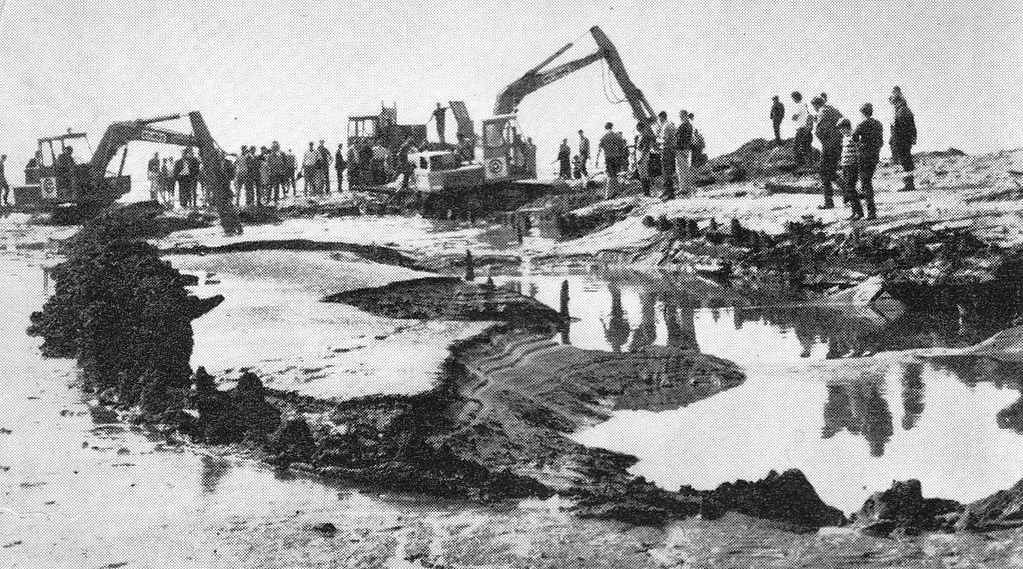
Digging into the wreck of the Amsterdam 1969.
1969 Aug 27 - The first Old Town carnival took place, because the town’s annual July carnival that year did not come to the Old Town. Organised in just over five weeks, the Old Town carnival started at Rock-a-Nore and went west as far as the fountain roundabout, and then returned via George Street, High Street and All Saints Street.
1969 Nov - A 200 ton, 100 feet long dredger was driven ashore near the Sun Lounge in Marina by a storm.
1969 Dec 30 - A large bath-house was discovered amongst the big Roman ironworks at Beauport Park by archaeologist Gerald Brodribb.
1970 Jan - The large beam engine at the Buckshole Reservoir pumping station was demolished. The station was built in 1875 to house the engine, and was re-equipped with gas engines in the early 1900s. The station had not been used for six years, and was replaced in coming months by a smaller electric station.
1970 Jan 8 - As the 45th annual Hastings International Chess Festival ended, The Times newspaper announced it was not renewing its three-year sponsorship, bringing serious financial problems to the organisers.
1970 Feb - Work began on changing the former Cinema De Luxe in Pelham Place into an amusements centre. It was built in 1899 as the Hippodrome Theatre of Varieties, later becoming the Cinema, until being converted into the Bingo Club. In 1970 major changes were made to the building, with the bingo moving to the upper floor and the ground given over to amusements machines. Some councillors had opposed the controversial project, but the proprietor Harry Simmonds was influential enough to be given the go-ahead by the Council's planning committee. An 'unofficial condition' was that he would close Harry's Old Town Bingo premises on the corner of All Saints Street and Rock-a-Nore Road.
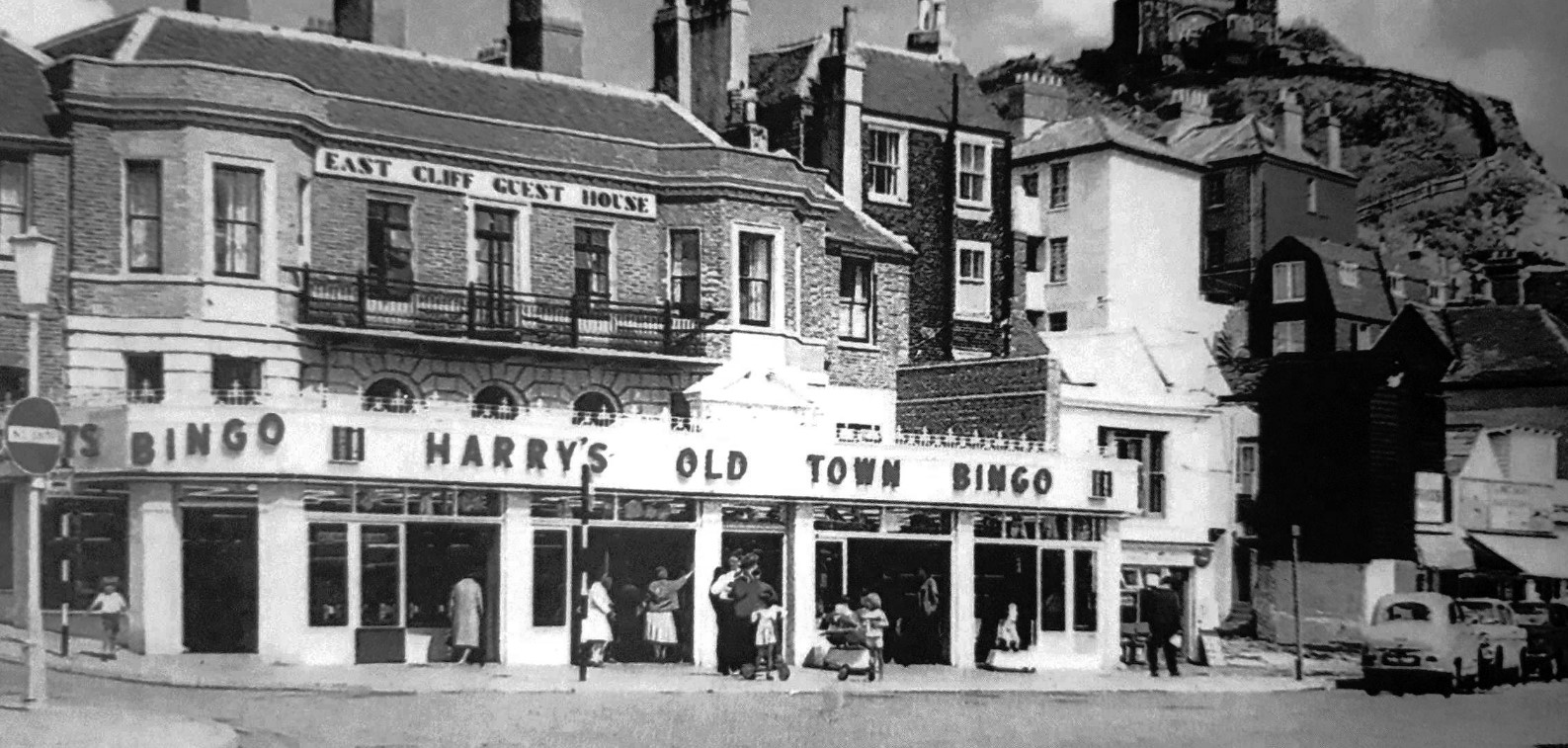
Harry's Old Town Bingo which Harry Simmonds had to close.
1970 March 5 - A two-hour snow-storm soon after 5pm brought near chaos to Hastings, with power failures plunging the town into darkness. It slowed traffic to a crawl and brought a number of accidents. There was a biting wind, and a freezing night followed.
1970 March 19 - Traffic Commissioners began an inquiry into alternative bus services between Hastings and Ashford following the decision by the Ministry of Transport in August 1969 that the railway line should be closed if a suitable bus service could be provided instead. There was strong opposition, and in late April 1970 the line was given a two-year reprieve, with the Commissioners blaming the bad roads.
1970 March 20 - A toy factory in George Street closed down suddenly and sacked the 33 women and girls who worked there. JK Farnell Ltd had been making soft toys upstairs at Nos 39 and 42 George Street, next to the steps to the West Hill, for about 11 years.
1970 March 24 - The town's oldest pillar-box was demolished by a lorry backing into it and smashing it into pieces. The fine Victorian pie-crust topped box had stood on the corner of Clyde Road and London Road. A replacement was sited against a wall a few yards up London Road.
1970 April - A large new extension to Hastings High School for girls on the Ridge was completed. It was built at a cost of £118,000 on the site of the original red brick building which opened as a school in 1901.
1970 April 14 - The Council decided to explore the possibility of providing the town with a marina, either in conjunction with repairing the deteriorating harbour arm, or siting it elsewhere on the seafront. This eventually came to nothing because it would not be financially viable.
1970 April 21 - The 19-year old local firm Buss Farmfresh Foods opened a large new factory in Drury Lane on the Ponswood Estate. The company had always been well-known for its tasty sausages which the Buss family had been making to a secret recipe for 70 years. Over 60 people were employed in its ultra-modern 7,500 sq ft premises.
1970 April 27 - The new Engineering Training Centre at Hastings College of Further Education in Archery Road was officially opened.
1970 May - Prime Minister Harold Wilson addressed the 700-strong National Conference of Labour Women at the White Rock.
1970 May - Opening of the new YMCA sports hall in St Pauls Road.
1970 May 4 - An ultra-modern Engineering Industry Training Centre, the first of its kind in the area, was opened at Hastings College.
1970 May 13 - Labour Prime Minister Harold Wilson addressed the 700-strong National Conference of Labour Women at the White Rock Pavilion.
1970 Late May - Hastings Council gave the go-ahead for major redevelopment of the Stade on the east side of the boating lake, the area of the Playland and the site of the East Hastings Sea Angling Association. It would be given over to amusements. It was also proposed that the land west of the boating lake should be comprehensively developed with grassed areas and games such as obstacle golf. This meeting gave birth to the Council's long-term policy of sacrificing what was left of the Hastings maritime heritage between the fishermens beach and Pelham Crescent to down-market seaside amusements.
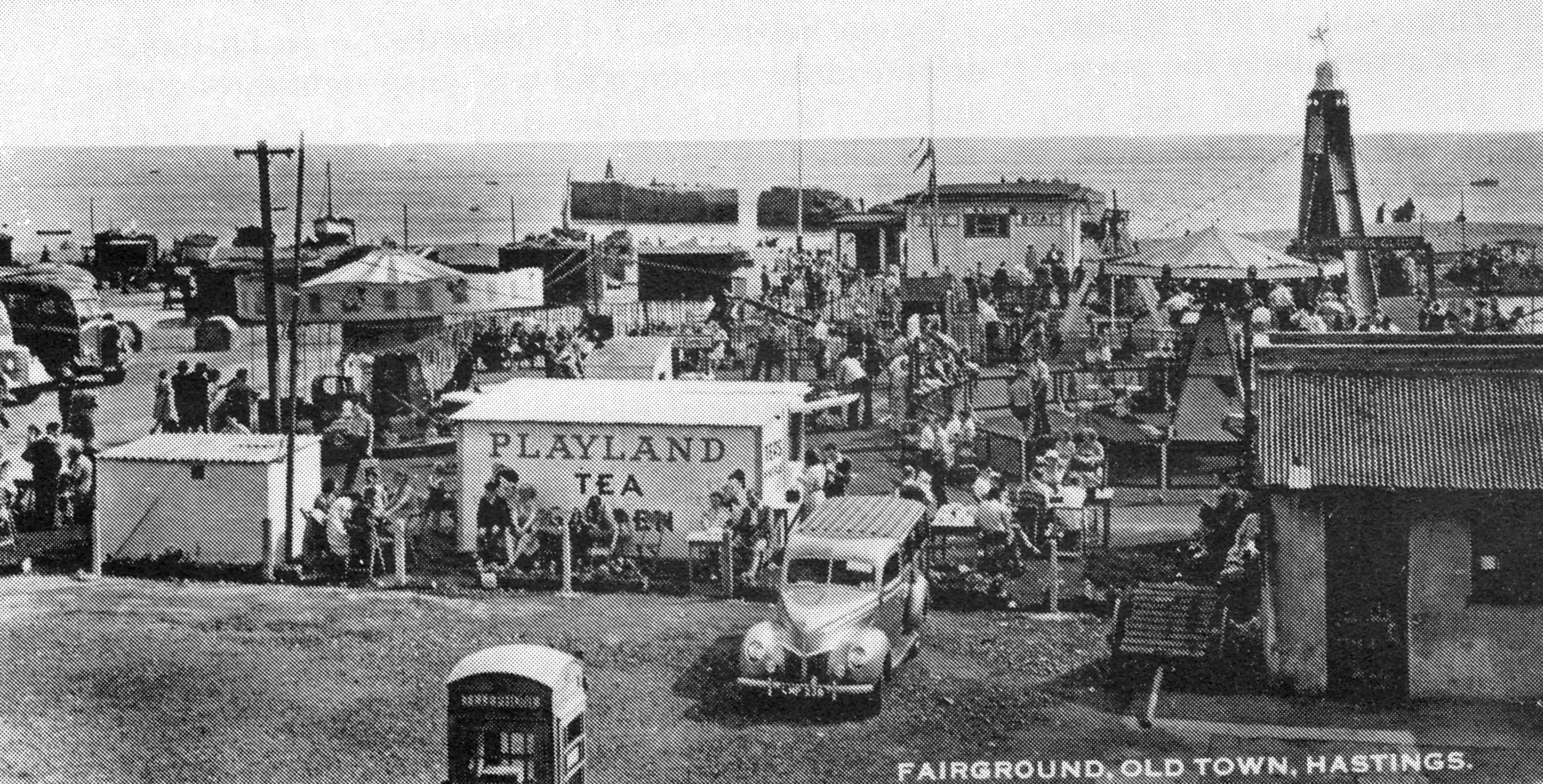
Playland in 1951, with the new lifeboat house in the background.
1970 June 3 - The large swimming baths at White Rock reopened after being closed since late 1969 while a new roof was put in place and the baths were redecorated.
1970 June 8 - The popular pub The Sun in Tackleway closed, becoming a house.
1970 June 8 - Torrential rain and fierce lightening brought flooding and damage to the town. Almost an inch of rain fell in just 66 minutes.
1970 June 18 - Tory Kenneth Warren was elected MP in the general election. He received 20,364 votes, Labour's Bernard Kissen had 13,549 and Liberal Pamela Shields 6,324. Mr Warren succeeded Sir Neill Cooper-Key who had been Hastings MP since 1945.
1970 June 25 - The Friends of Priory Meadow group was set up at a meeting in the town hall of people concerned that the century-year old cricket ground in the town centre would be sold.
1970 July - Work was completed on building a large extension to the Hastings Observer offices at 53 Cambridge Road. Numbers 49 and 51 Cambridge Road had been demolished in the late 1960s and the nine-storey Rothermere House office block was built, costing £150,000. It then became the nerve-centre of the many newspapers and magazines that FJ Parsons Ltd then owned. In 1954 Parsons had added a seventh floor to No 53, and then in 1959-61 had added a five-storey major extension up Prospect Place on the sites of Nos 5 and 6.
1970 July 4 - The well-known Langham Hotel on the corner of Mount Pleasant Road and Elphinstone Road was badly damaged by a fire which broke out in the public bar.
1970 Mid-July - Work was due to start soon on the first stage of the extension of Grove Secondary School. It was to cost £270,000. When it opened in early September 1972 the school absorbed the pupils of the Woodlands girls school, making the total number of pupils over 1,400.
1970 Early Aug - Site clearance work had begun for constructing the new police station at Summerfields. Costing £310,000, the new HQ would replace the one in Robertson Terrace. It would include residential quarters and a rifle range.
1970 Aug-Sept - St Andrews Church in Queens Road was demolished. A small fragment of a mural by author Robert Tressell was found beneath a layer of white paint as demolition work began, and it was rescued (it is now in the Museum). The church stood where Morrisons petrol station is today. It was consecrated on 30 November 1870 - St Andrews Day. A new aisle was added in 1873, increasing to seating to 600-700, but by 1970 it was little used.
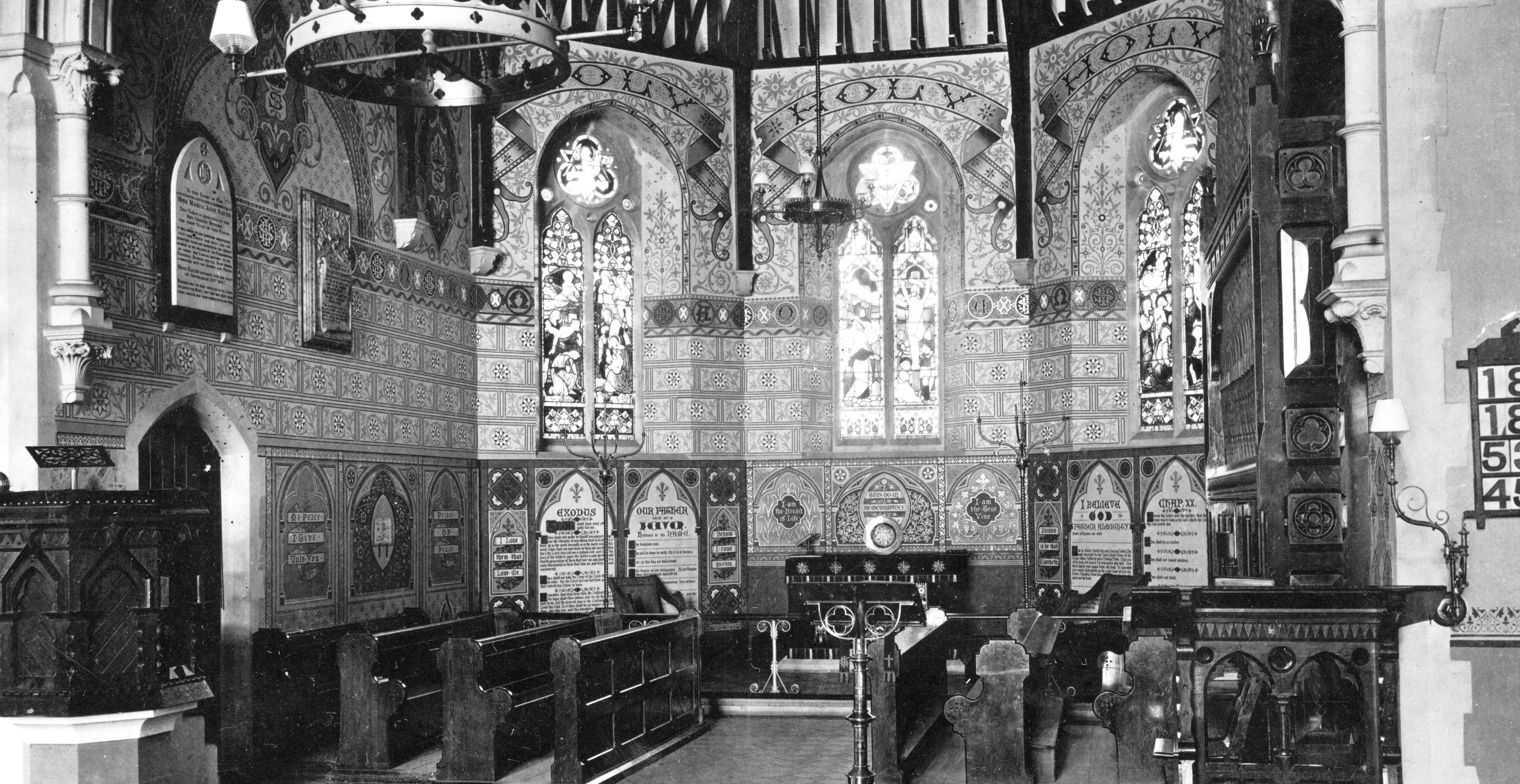
Robert Tressell, author of The Ragged Trousered Philanthropists, is believed to have painted the St Andrews murals.
1970 Mid-Sept - A big new sports compound opened at the YMCA's centre in St Pauls Road.
1970 Sept 25 - A large quantity of human bones were found in St Michaels Place by workmen cutting into the bank opposite the top end of Dorset Place to make room for an electricity sub-station. Museum curator John Manwaring Baines thought they could date from about 1300. The bones were from at least 13 people, and were at a depth of eight feet in a single grave. It is possible they were originally buried separately in the St Michaels Church graveyard, and then relocated to this site when the cliff was cut back.
1970 Sept 30 - A big new factory, VG Electronics, opened in Menzies Road on the Ponswood estate. It had cost £120,000 and could employ 250-300 people. VG was short for Vacuum Generators.
1970 Oct 13 - Hastings Council approved plans for the creation of a national country park, taking in the many acres of cliffs, glens and farmland to the east of the town which it already owned. This would allow the area to be properly administered and maintained, and would qualify for grants and other assistance. The Hastings Country Park opened six months later.
1970 Nov - Under new legislation, the Hermitage convalescent home in Holmesdale Gardens was forced to close. It opened in 1928 and 87,000 patients had stayed there.
1970 Early Nov - A three-week strike by Hastings refuse workers, part of a national dispute, ended with the workers being given a 16% pay rise. Large amounts of rubbish had been dumped in the approach road to Pebsham tip. Ratepayers faced a bill of £130,000.
1970 Late Nov - The Hollington Juniors Action Group won their nine-month campaign to have a new school. The Department of Education and Science announced that £101,000 would be spent in 1972-73 on a new junior school in the grounds of the existing infant school, which was in bad condition.
1970 Dec 7 - Electric power workers started a national work-to-rule, and the massive cuts plunged Hastings into darkness, affecting almost all households and industries. The dispute ended on 15 December.
1970 Dec 12 - The new church at Fairlight Cove was dedicated.
197o Dec 30 - A serious fire caused £30,000 damage to the Cobweb and Dolphin ballrooms at the east end the 13-storey Marine Court block of 168 flats and 20 shops on St Leonards seafront. Nearly 100 residents had to be evacuated from the adjoining 'A' block of flats in Marine Court. There were no casualties. In June 1971 Marine Court was bought for £400,000 by the Woodmill Property Group of London, which said it would restore the ballrooms. But this did not happen, and January 1976 they re-opened as 15,300 sq ft of offices, called Hanover House.
1971 - The Vivo Foodrite supermarket was built on the site of the old Roxy Cinema at Silverhill, on the corner of Beaufort Road.
1971 Jan - The new underground York and Crypt Bars in Robertson Street opened.
1971 Jan 6 - A dozen days of heavy snow, ice and strong winds came to an end. It was said to be the worst winter weather since 1962-63.
1971 Jan 18 - The number of unemployed people in Hastings, Bexhill and Rye had reached its highest-ever level, it was announced. There were 1,750 workless in the area, with 1,010 men and 130 women in Hastings.
Building the new bridge over the A21 at Harrow in 1971.
1971 Jan 22 - The 130-year old Harrow Bridge over the A21 was demolished. Work on replacing the narrow brick arch with its stone parapets began in August 1970. The A21 re-opened after seven days closure, and the replacement two-span bridge was scheduled to be completed by the autumn. The original bridge was built in 1838 as part of the construction of a new six-mile long turnpike road connecting the new town of St Leonards with the existing Hastings-London road at Woodmans Green north of Whatlington, where the white church and sharp bend are on the A21 today. The new road was the idea of James Burton, founder of St Leonards, who wanted the London-based users of his new town to be able to travel there much easier than by using the old Whatlington-Battle-Telham-Ore-Hastings seafront route.
1971 Late Jan - Work began on demolishing the Glyne Gap gasworks. The works, which closed in 1969, were on a 20-acre site, whose future had not then been decided by the South Eastern Gas Board. In late March the tall chimney at the works was blown down by 30 sticks of hign explosives. In early June the 1,000-ton batching plant for grading coke was also brought down by explosive. It had stood on eight legs. [The site is now the Ravenside shopping centre.]

The gasworks at Glyne Gap as demolition started in 1971.
1971 Feb 15 - This was Decimal Day - the first day of Britain's decimalised currency.
1971 Feb 25 - The new £193,000 fire brigade headquarters in Bohemia Road was opened. It replaced the badly-sited HQ in Seaside Road, built over 90 years before, which was only a third the size of the new base.
1971 March 8 - After a seven-week strike, 350 local postal workers returned to work.
1971 Mid-March - Hastings Council asked about 30 owners of property in Wellington Square to redecorate the outside of their houses in accordance with a carefully prepared colour scheme. The Council would paint in its own properties in the Square in the same way.
1971 April - The government officially approved the 1968 Town Expansion Scheme proposal. Londoners and industry were, in theory, to be brought to Hollington in the £23½ million 10-year scheme. [Eventually the town expanded and the Londoners came, but the industry did not.]
1971 April - The 121-year old West Hill Lift came back into operation after having its manually controlled 32hp diesel engine replaced by a new electrically-operated drive.
1971 April 1 - Hastings Country Park officially came into existence, under the 1968 Countryside Act. It initially comprised 512 of the 830 acres the Council owned between the Old Town, North’s Seat and Fairlight Cove. It was officially declared open on 13 July 1974.

The Country Park Nature Reserve in 2019.
1971 May - Sainsbury's announced they hoped to open a new supermarket in Cambridge Road in about three years. They had bought property owned by Skinners Motors between Priory Street and Cambridge Gardens.
1971 May - HM Coastguard announced that for the first time a helicopter would be available in the English Channel to aid lifeboat rescues, including Hastings.
1971 Early May - Work began on building the pedestrian subway system under the seafront at Harold Place, as part of the town centre traffic management scheme. Utilising part of the underground car park, it would provide a safe pedestrian route from the promenade to the town centre. It would cost £52,000, with the government paying 75%. It was officially opened by the mayor on 27 July 1972.
1971 May 13 - In the Hastings Council local elections, the Labour Party did surprisingly well. A successful candidate for the first time was 25-year old Michael Foster, fighting his fifth election, who went on to become the first Hastings Labour MP in the 1997 general election.
1971 May 28 - Civic opening of the first new cinema in Hastings since 1938. The new 165 seat Classic 2 was a cinema within a cinema - the converted Classic Cinema (formerly the Gaiety) in Queens Road.
1971 June 8 - Opening of the new 3,500 sq ft Co-op superstore in Sedlescombe Road North at Silverhill.
1971 June 25 - Prince Philip paid a flying visit - by helicopter - to the Fairlight Coastguard Station.
1971 June 26 - Charles Levett, manager of Baldock's men's outfitters at 34 George Street, was murdered at his home, 18 St Marys Road. He was stabbed 14 times by two men who took the shop's money and set his house on fire. In November 1971 two Eastbourne brothers were jailed for life.
1971 July 10 - Fire broke out in the remains of the Clive Vale Congregational Church on the corner of Edwin and Githa Roads. It was being demolished, and the contractor was planning to build houses on the site.
1971 July 17 - It was announced that the first steps had been taken to merge the Hastings and Thanet Building Society and the Hastings and East Sussex Building Society. The HTBS was the outcome of a merger in 1951 of the Hastings Permanent (founded in 1849) and the Isle of Thanet Building Societies. The HESBS was founded in 1851. The headquarters would be the HTBS building Thrift House, in Bexhill. The new society would be called the HTBS, and one of its branches would be the old HESBS headquarters at 13 Wellington Place.
1971 Aug 1 - The long-awaited clubhouse of the Hastings Motor Boat and Yacht Club at Rock-a-Nore was declared open. The £3,500 clubhouse was built in a factory before being brought to Hastings and set up on the site of the former Hastings Sewer Manure Works. A 3 cwt boulder fell down the cliff and through the club's roof on 13 November 1971.
1971 Aug 9 - A 14-year old hippie girl from Liverpool was found dead in a house in Earl Street. Pauline Roberts was one of a group of hippies who had been living in the woods and glens of the Country Park. On 12 December 53-year old Omar Kassem, a former wrestler known as The Terrible Turk, was jailed for five years for Pauline's rape and manslaughter.

The upper circle of the ABC as the cinema was being demolished in 1971.
1971 Oct 6 - The ABC Cinema, the biggest and best cinema in Hastings, closed, with its last film being Le Mans, starring Steve McQueen. The 2,000 seat cinema in Cambridge Road had opened in March 1938 as The Ritz, and its closure was seen as a big loss to the town's culture, with the only remaining cinemas being the Classic 1 and 2 and the Orion, against a total of eight when it opened. A special feature had been its mighty Wurlitzer organ, which was dismantled in 1964 to make way for a new heating plant! The ABC was demolished over the winter to make way for the new Sainsburys supermarket which would not be built for some years [it is now ESK]. In late 1972, archaeologists found the remains of a small chapter house on the site. This was part of the medieval Priory, which had a church under Cambridge Gardens and Cambridge Road.
1971 Oct 10 - Sixty acres of Warren Glen were destroyed by a raging fire, with flames leaping over 50 feet into the air. It swept up the east side of the glen and would have reached the Coastguard Station but for the hard and dangerous work of the fire brigade.
1971 Oct 18 - The Cashmart Cash and Carry Depot opened at Menzies Road on the Ponswood Estate. The huge 25,000 sq ft warehouse was stacked hire with large quantities of retailers goods. It was not open to the general public.
1971 Oct 19 - In a town poll on whether Britain should join the Common Market, 77% of those who voted (11,592 out of 15,102) opposed it. The referendum was organised by a group of local people against the Common Market, who distributed 55,000 ballot forms inviting voters to say 'Yes' or 'No'. The poll turnout was 27.6%, and the votes were counted at the White Rock Pavilion. But that evening, borough MP Kenneth Warren told a packed meeting at the Hastings Pier ballroom that he was a staunch supporter of Britain's entry to the EEC, and he would carry on campaigning for it, despite the result of the referendum.
1971 Oct 20 - The wide new £104,000 Harrow Bridge over the A21 at Harrow was opened. The two-span pre-stressed concrete construction replaced the old narrow tunnel-like bridge, only 16 feet wide, which for many years had formed a dangerous bottleneck on the A21.
1971 Oct 20 - After 25 years service on Hastings lifeboat - the last ten as coxswain - Mr Jack Edmunds retired. He was succeeded by Mr Joe Martin.
1971 Nov - The new Fairlight Coastguard look-out tower came into operation. The 30ft high tower had good vantage and improved radio communications.

The Fairlight look-out tower in 1984.
1971 Early Nov - It was decided that the Central Abattoir in Junction Road, Harrow, which was owned by the Hastings, Bexhill, Battle and Rye local authorities, should be leased to the Brentwood-based firm Andrew Cheale Ltd. It had consistently lost money since it was built in 1965 at a cost of £210,000 to serve a total population of 133,000. In 1976 it was sold to the company, but the national recession in the following years made it unprofitable, and in May 1981 it was put up for sale. It had been handling about 1,500 animals a week, mainly for the export trade.
1971 Nov 8 - A new 250-space car park opened on the former goods yard next to Hastings Station.
1971 Nov 24 - A 66-page report on the feasibility of having a marina at West Marina or the harbour was submitted to Hastings Council by consultants Sir William Halcrow and Partners. Either would cost about £10 million, with the West Marina site favoured. But nothing came of the report.
1971 Dec 23 - FJ Parsons Ltd, the family-owned local printing company that had published the Hastings Observer for over a century, announced that it had been bought out by magazine publishers Morgan-Grampian Ltd. FJ Parsons Ltd at that time controlled several other papers in Sussex and Kent, and had printing plants in Hastings, Bexhill, Lewes and Folkestone. They also had subsidiaries, including the Travel Trade Group. In December 1973 Morgan-Grampian sold to Westminster Press Ltd.
1971 Dec 29 - The last Borough Quarter Sessions were held in the town, coming to an end after more than four centuries. In future cases were sent to the new Crown Courts at Lewes and Brighton, which replaced the Assize and Quarter Sessions. Many Hastings cases used to be committed to the Sussex Assizes at Lewes, the last of which was held on 20 December after 756 years.
1972 Early - The small old fire station at the west end of Seaside Road, St Leonards, was demolished.
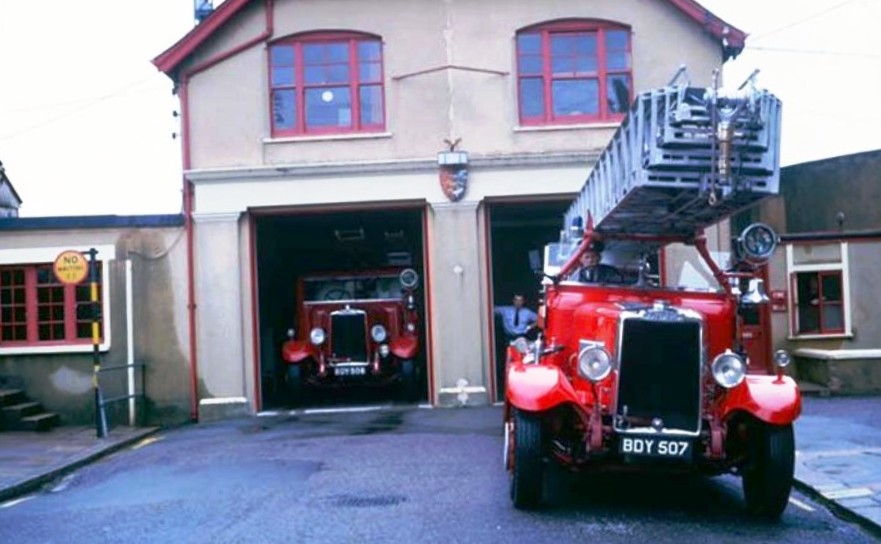
The fire station at the west end of Seaside Road.
1972 Jan 6 - Well-known fisherman Thomas Henry Adams, (known as 'Tom Toller') aged 45, of 50 All Saints Street, was found dead on board his one-man boat Lorraine and Carol RX 16 with his head trapped in a winch.
1972 Feb - The 1877 Croft Chapel on the corner of the Croft and Croft Road was demolished to make way for 12 flats. The tall red-brick building had been squeezed into a small space, and for a long time had been a familiar sight to Hastingers.
1972 Early March - British Rail began a two-month project erecting a 100-ft retaining wall at Bulverhythe to protect the Hastings-Bexhill railway line from sea damage.
1972 March 3 - Education Secretary Margaret Thatcher MP told 600 people at the White Rock Pavilion about how local authoritites, such as Hastings, should reorganise secondary education. But on 11 April Hastings Council voted 22-11 to retain its two selective schools - the Grammar School for boys and the High School for girls. This highly controversial decision ran counter to the national movement towards comprehensive schools. In the 18 months before this vote, there had been many consultative meetings with the public where the parents voted two to one in favour of comprehensive schools.
1972 April - The former Grammar School in Nelson Road was demolished, having stood empty since the school moved to Parkstone Road in autumn 1964.
1972 April 6 - The Hastings Old Town Residents Association (HOTRA) was formed at a meeting in St Clements Church Hall. There was special concern over Stan Deboo's strongly opposed amusement proposals for the Stade. But on 11 April Hastings Council gave Deboo the green light for his scheme.
1972 April 11 - Hastings Council gave the go-ahead for the creation of the Castleham Farm industrial estate on the west side of Battle Road. The cost for the Council was estimated at £600,000, with the first phase being to build Telford Road, the estate's access road from Battle Road, starting in July. Bulldozers began clearing the site in mid-August and the main construction work was expected to start in early 1973.
1972 Summer - Marine Court had its first major refit since it was built in 1937. The 170 ft tall building on St Leonards seafront had 168 flats, a parade of 20 shops and approx 1,650 sq ft of office space.
1972 May - Work began on the £50,000 scheme to improve traffic management around the Memorial clocktower in the town centre, where seven roads converged. Over the following six months traffic channels were rerouted, a system of traffic and crossing lights installed and pavements widened.
1972 May - The Hastings Area Archaeological Research Group was formed. Its first 'dig' was on the site of a 17th century farm at Summerfields.
1972 May 4 - The municipal elections were the last which Hastings held as a Borough Council, before the nationwide changes in local government in 1974. The Tories won 25 seats, Labour 10, Liberals 4 and one independent.
1972 May 19 - The town's only woman traffic warden retired. Mrs Connie Wyatt had been a warden from 1965, but was leaving to start an indoor job.
1972 May 27 - The 1971 census figures were released, showing Hastings had many more females than males - 40,750 against 31,420, making a total of 72,170.
1972 July 1 - Three elderly women were killed when a dramatic fire swept through the town's third largest hotel. Sixty firemen and ten fire engines fought the blaze in the Yelton Hotel [now the White Rock Hotel] on the seafront opposite the pier. The firemen brought 32 people out of the building. The fire was caused by an electrical fault.

The former sand quarry at Fairlight being cleared.
1972 July 17 - The Hastings Country Park's first warden, Mr J Heathcote, took up his duties. This was a time when many improvements were being made. The Fairlight Down car park on Fairlight Road had already opened and toilets were being installed. By September the Fairlight sand quarry, close to Fairlight Church, had been cleared of buildings, and work began on a new road and car park. In early 1970 drilling had been carried out at the quarry in an unsuccessful search for natural gas.
1972 July 19 - The new Hastings police headquarters in Summerfields, Bohemia Road, costing £400,000, came into use. It replaced the small station in Robertson Terrace. The Hastings Police Division (tel: Hastings 5000) had 300 officers and covered a population of 160,000. The building was officially opened by the Duke of Norfolk that October 11. Hastings Council was then still planning to build a new ‘civic centre’ (town hall) at Summerfields, but this did not come to fruition.
1972 Aug - Castleham Farm, Hollington, was demolished as the Town Expansion Scheme got under way. Clearance of Tile Kiln Farm in Churchwood Road took place in October.
1972 Aug-Oct - The large Mastins Department Store in Castle Street was demolished to make way for an office block (Cavendish House). It had closed down on 27 September 1969 because of increasing costs and had stood empty since then. Founded in 1872, it became one of Hastings' best-known family concerns. In March 1975 the six-floor office block Cavendish House which was built on its site was officially declared complete by the mayor.
1972 Sept 9 - A 47-foot fishing boat, the RT Curry, was beached in a gale in front of the Hastings fishing boats. The three crew, from Sunderland, abandoned the vessel which was pounded by the seas, breaching a hole in her starboard side. Over following days much of her equipment was stolen. On 20 September Hastings Council workmen dismantled and burnt the boat because it was obstructing the launching of other boats.
1972 Oct 4 - Fire ravaged about 45 acres of gorse on the Fire Hills at Fairlight. Four fire engines with 25 crew fought the fire for 24 hours.
1972 Oct 14 - Hastings was twinned with the industrial town of Bethune, in northern France.
1972 Oct 22 - The last service was held in the 1878-built Mount Pleasant Congregational Church, on the corner of Mount Pleasant Road and Hughenden Place. It was demolished in the following months to make way for a block of 47 flats.
1972 Nov - A new 170 ft tall TV mast was erected on land adjacent to St Pauls School in Amherst Road. On 27 July 1973 this aerial relay station began providing 625-line colour transmission on BBC1, BBC2 and ITV, covering 95% of the Hastings area. This improved TV reception quality.
1972 Nov-Dec - The first 'mini-roundabout' in Hastings was installed at the junction of St Helens Road and Sedlescombe Road North.
1973 Jan-Feb - Summerfields House, which was a well-known boys’ prep school from 1903 to 1966, was demolished. Hastings Council had bought the fine Georgian mansion, built in 1824 as Bohemia House, and its 47 acres of parkland to create a civic centre complex, including ambulance, fire and police services.
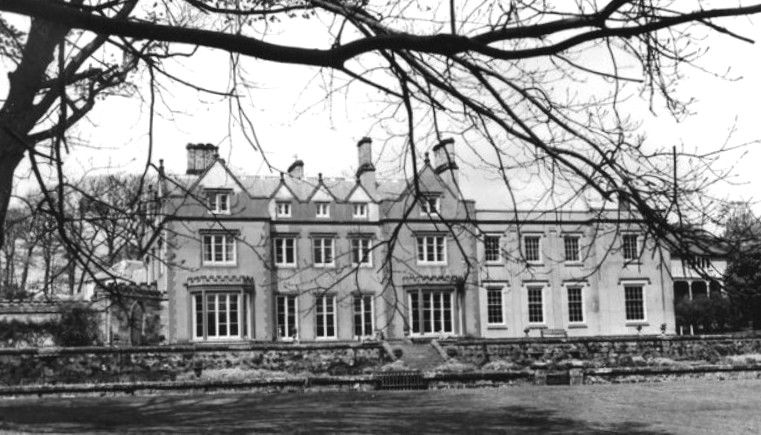
Summerfields House.
1973 Jan 5 - The first sitting of the Hastings divorce court took place. Until then the nearest divorce courts were at Brighton and Tunbridge Wells. The proceedings were in the town hall, as the new courts building in Bohemia Road would not be ready until 1974.
1973 Jan 16 - Twenty-eight Hastings fishermen who were crowded into Hastings Magistrates Court were fined a total of £243 for obtaining over £400 unemployment benefit by deception in 1972. Each was fine £3 on each case and each was ordered to pay £1 costs. They had pretended they were not working, and therefore qualified for benefit, when in fact they were working. The chairman of Hastings Magistrates said the case had brought a cloud over the community.
1973 Jan 19 - The new £30,000 Civil Service sports hall and clubhouse in Harrow Lane was officially declared open.
1973 Jan 22 - The new national postal code system came into use in Hastings and much of the surrounding area, with Bexhill starting on 29 January. Other the past two years coding officers had given every houses, flats and premises in Hastings a post code. The Observer offices in Cambridge Road were given the code TN34 1DY (DY was also the number plate code for cars and other veicles registered in Hastings).
1973 Feb - The new clubhouse of the East Hastings Sea Angling Association was completed on the Stade, near the lifeboat house. Costing £20,000, it replaced the old hut that had been the HQ for over 30 years.
1973 March 16 - The big store Plummers in Robertson Street was renamed Debenhams. Mr Plummer opened a store on this site in 1868, with the Debenham Group being the owners since 1931. The Group, Britain's largest store group, was changing the names of all the stores it owned to Debenhams.
1973 March 30 - A well-known Old Town personality, 29-year old Peter Trickett, was jailed for two years at Lewes Crown Court for stealing valuable paintings, silver plate and other articles, worth £3,446, from a house in All Saints Street. The court was told Trickett had had various labouring jobs and was working for fishermen as a boy ashore. It was also said that he was "bedevilled" by his problem with alcohol. He had five previous convictions.
1973 Spring - Actor Mark Singleton sold 58 acres of land south of the Ridge to Hastings Council for £1.5 million. The land was part of the Beauport Park estate and was to be used for the town expansion starting to take place. Singleton, 53 years old, had inherited the 1,200 acre estate from his father.
1973 April-Nov - The Regal Cinema in London Road, opposite Pevensey Road, which had been closed for many years, was demolished in preparation for building a huge and ugly 12-storey office block there. It was opened on 6 August 1932 by the mayor, and the opening film was Jack's the Boy, with Jack Hulbert. It had presented films and live shows, with many well-known entertainers appearing there.
1973 April 1 - The Value Added Tax (VAT) system came into operation. All traders were required to register for it.
1973 April 4 - Death of one the town's greatest ever benefactors, Miss Isabel Blackman, in her 80th year. She had been left a large fortune by her father, the late Alderman Arthur Blackman, a prominent local businessman. She gave generous support to many charitable and other organisations, much of it through the Isabel Blackman Foundation. Donations included the 70 acres of St Helens Wood.
1973 April 12 - The first elections were held for the new East Sussex County Council, which was to take over control on 1 April 1974 as part of the national reforms of local government. In Hastings, the Tories performed worse than expected. The Labour, Liberal and Tory parties each won three of the nine seats. The first meeting of the 84-strong County Council took place in Lewes on 27 April. There were 48 Tory councillors, 19 Labour, nine Liberal and eight independents. The last reorganisation of local government was in 1894.
1973 April 28 - The top of the 65 feet high Albert Memorial clock tower, built 1862-64 in the town centre, was partly damaged by fire at about 1.00am. The fire-fighters were at the Memorial within two minutes of receiving a message about the fire, and they extinquished it in 10 minutes. The belfry and pinnacle were removed in late June after a second small fire. Unlike most residents, senior Hastings councillors and council officers did not like the Memorial because of the traffic management problems it caused, and they demolished it in late November 1973. Many people saw this as Hastings needlessly losing its symbolic heart. The statue of Prince Albert that had been on the south face of the Memorial was bought from the demolition firm by a a local resident, Miss Edith Skelton. It was stored in a greenhouse in Alexandra Park until being erected alongside the town hall in 2017.
The Memorial being demolished in November 1973.
1973 May 2 - Residents of 127 small terrace homes in central St Leonards - bounded by London Road, Gensing Road, Norman Road and Silchester Road - met to form an association to fight the Council which was threatening the 'renew' this part of St Leonards using a slum clearance scheme. In December 1974 Hastings Council lifted the 22-year-old clearance blight hanging over the houses, many of which had been built in 1836-38 following the clearance of the America Ground, with builders using parts of the demolished properties.
1973 May 21 - Torrential rain coinciding with a near high tide and a blocked outfall in a key area - Harold Place - for an hour created the worst floods seen in the town centre for many years. There was also extensive flooding in Filsham Valley.
1973 June 7 - The first elections were held for the new Hastings District Council, a creation of the 1974 re-organisation of local government. There were 33 seats; Tories won 12, Labour 11, Liberal 9 and Independent one. The new council took over power on 1 April 1974.
1973 Mid-June - One of the country's leading travel agents, Exchange Travel, announced it was going to move its headquarters from London to Hastings, following its purchase of the former Seeboard office block in Parker Road.
1973 July - A new bandstand was erected in Warrior Square Gardens, at the south end. It was a prefabricated 'bolt together' structure.
1973 July 1 - The new golf course at Beauport Park was officially declared open. It had taken three years to construct and cost about £200,000, a third more than projected.
1973 July 31 - The oldest family bakery in the town closed down after 141 years being run from the same premises by the same family. Beck's Bakery at 6 East Ascent had been opened in 1832 when the township of St Leonards was being built. Bill Beck and his sister Sheila had wanted to carry on running the business, but the Council's Public Health Committee had said that his basement bakehouse, with its 111-year old coal-fired oven and 40-year old dough mixers, was no longer suitable for the production of food. The necessary changes would have cost to much to implement, so the business closed down.
1973 Aug - Construction company Streeters began an 18-month drainage contract in west Hollington as part of the major expansion of Hastings. They were to build an 8.77 acre lagoon holding nearly 3m gallons of water from a catchment area of 467 acres.
1973 Aug-Sept - A large area of the beach opposite Pelham Place and Sturdee Place was covered with soil in preparation for two golf courses being laid out there. The Old Hastings Preservation Society opposed the scheme, but their views were ignored.
1973 Sept - Hastings fishermen, concerned at the possible threat of foreign beam trawlers destroying the local fishing industry, set up the Hastings Fishermen's Protection Society. This was separate from the Hastings Fishermans Society, a mutual benefit society set up in 1831.
1973 Sept 10 - Mr David Devenish, aged 35, started work as the new curator of Hastings Museum. He replaced the retiring curator Mr John Manwaring Baines, author of the definitive history of the town, Historic Hastings. JMB, as he was known, had been curator since 1935.
1973 Sept 11 - The new Blackland Primary School in Freshwater Avenue opened its doors to its 222 pupils. It was the first open-plan school to be built in the borough.
1973 Sept 13 - Launch of the free newspaper Hastings News, the first weekly rival to the Hastings Observer for six decades. It was a low budget freesheet, originally published on Thursdays, two days before the Observer, forcing that complacent paper to try to improve its poor-quality reporting. The progressive News played an important role over th next decade in both giving voice to more liberal politics and inspiring cultural movements around the town. But it was bought by Senews in 1985, becoming part of the Observer group, although it retained its editorial independence until August 1990.
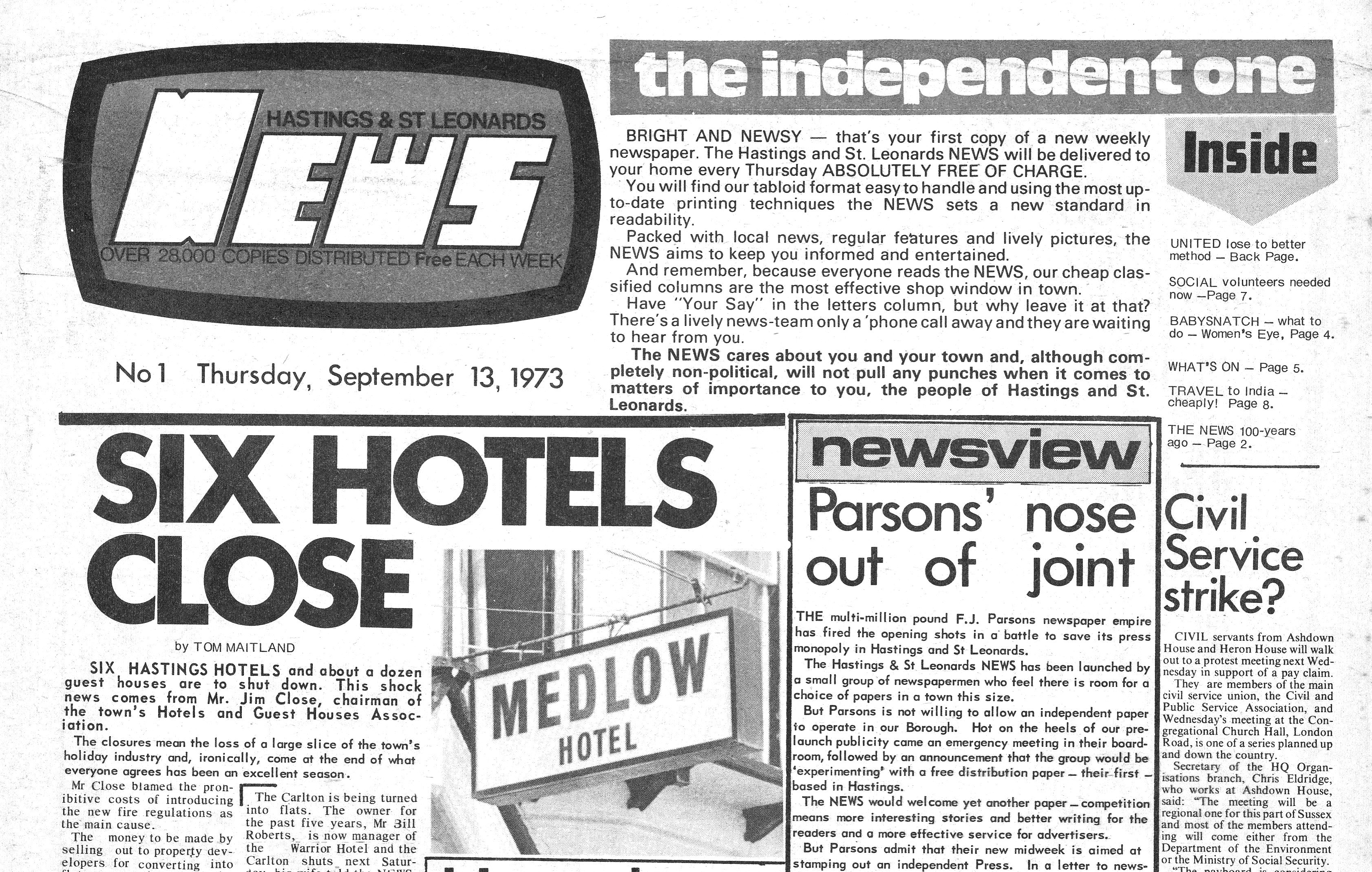
The first edition of the Hastings & St Leonards News.
1973 Sept 29 - Fine Fare, the first 'supermarket' to be set up in Hastings, closed down. When it opened in 1959 on the corner of Queens Road and South Terrace, Sainsbury and Tesco both had old-style stores in Wellington Place, but Fine Fare was the first shop to have a line of tills through which customers passed, rather counters.
1973 Oct - The first bricks were laid for the first of the town development area estates: Tilekiln, off Wishing Tree Road, where 337 houses were planned. A large lagoon was being dug north of Grove School to take the run-off from the proposed new estates. Factories were being constructed on the new Castleham industrial estate.
1973 Oct - The site of Hydneye House, formerly a well-known prep school on the Ridge, was purchased for £118,000 by Hastings Council, on which to build Maplehurst secodnary school.
1973 Late Oct - Hastings Council's new mobile library came into service. Carrying 3,500 books, it visited 20 sites in the town, with a staff of two librarians and a driver.
1973 Dec 8 - Morgan-Grampian Ltd announced that it had completed its sale of FJ Parsons Ltd, the publishing company of the Hastings Observer and other newspapers, to Westminster Press Ltd. The sale had been initiated in July 1973, and then referred to the Monopolies Commission, which gave approval in late October. Mr Frederick Parsons retained his link with the company as a director. He had joined the board in 1926, becoming chairman and managing director on the death of his father Joseph Parsons in 1935. He retired on 24 October 1976 and died a fortnight later at his home, Twisly, Catsfield, aged 75. The Parsons family had sold FJ Parsons Ltd to Morgan-Grampian in December 1971.
1974 Jan 5 - According to councillor Ted Ive, chairman of the Joint Development Committee, the £27m Town Expansion Scheme should not be affected by the current national crisis. The first house should be occupied and the first factory opperational by the end of the year. The plan's target remained 15,000 Londoners, with industry here by 1981.
1974 Jan 21 - Work began on constructing the West Hill Community Centre, on the south-east corner of Croft Road and Bembrook Road. The £15,000 Centre, created by the West Hill Association, was officially opened on 28 September 1974. It was built by one of the town's oldest building firms, AE Goodsell & Son.
1974 Feb 2 - Hastings United Football team walked off the pitch soon after the start of the second half of their F.A. Challenge Trophy second round tie which they lost 5‑2. The protest followed three penalties against Hastings and the sending off of their captain.
1974 Feb 11 - A mother - Mrs Hazel Ann Edwards, aged 30 - and her three young children died in a fire, trapped in a flat above an office storeroom in Middle Street.
1974 Feb 13 - The famous and popular Demarco's cafe and ice cream parlour at 6-8 Pelham Arcade closed. It had been there since 1905.
1974 Feb 28 - In the general election, the Tory Hastings MP Kenneth Warren retained the seat, with 20,075 votes. Second was Labour's Michael Foster with 12,992, and third was Liberal Gerald Cass with 11,690. Hastings had been a Tory seat since 1906, when sitting Liberal MP lost to rich Irish businessman Harvey Du Cros.
1974 March 27 - The town's first helipad was opened by the mayor. It was on the site of the former RAF station in Fairlight Road, adjacent to Martineau Lane. It was also a car park.
1974 March 30 - Over the next three weeks, the town's 110 public telephone kiosks were converted to the new STD (Subscriber Trunk Dialling) system.
1974 April 1 - Under the Local Government Reform Act, Hastings County Borough Council, which met for the last time on March 12, went out of existence on 31 March, being replaced by Hastings Borough Council, which met for the first time on 10 April. Control of its libraries, fire brigade, highways, education and social services went to East Sussex County Council. Cllr Horace Funnell, a Labour Party member for nearly 50 years, became the first-ever Labour mayor of Hastings. Domestic rates went up an unprecedented 40% for 1974-75 to meet the costs of the re-organisation.
1974 April 2 - Death of well-known local farmer Arthur Frederick ('Freddy') Funnell, aged 72, of Shearbarn Farm in Barley Lane. He bought the dairy farm in 1927, but became famous (and notorious) from the late 1940s onwards for the ways in which he managed to turn it into a large camping and caravan site, with a big dance hall. In December 1974 the whole farm - 46 acres, with licences for 250 caravans and 250 camping units - was sold to a group of businessmen,
1974 April 24 - The new automatic STD telephone exchange at the bottom of Havelock Road came into operation at 1.30pm. It replaced the out-of-date manual exchange (possibly the largest in the UK) that had been upstairs at the post office in Cambridge Road since it was built in 1930. The new one had taken three years to build, partly because of the need to sink piles 75 feet into the underlying shingle. The building cost £650,000, with the switching equipment a massive £2.2m in addition. The initial STD code for Hastings was 0424. Most subscribers were given new 6-figure phone numbers beginning with 42 or 43.
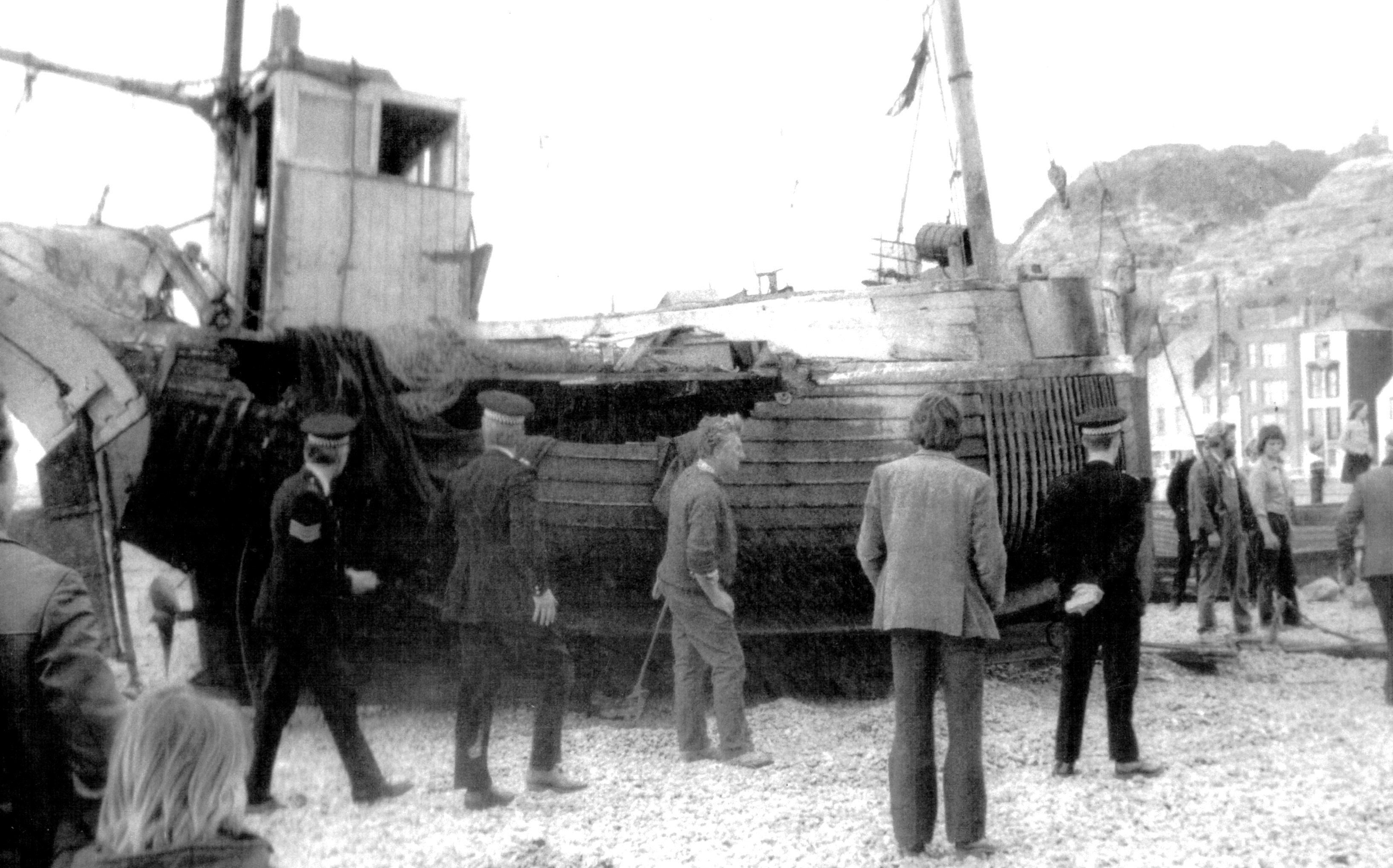
The Valiant being hauled up the beach after the accident that killed George Mitchell.
1974 April 23 - Hastings fisherman George Nelson Mitchell (57), of All Saints Street, was killed when his fishing boat Valiant RX 90 was struck by the 400 ton 135ft coaster Frederick Hughes 4 miles south of Fairlight. The coroner recorded a verdict of 'accidental death'.
1974 May 7 - Cllr Horace Funnell was the first Labour mayor of Hastings, elected at a Council meeting.
1974 May 26 - The last service was held at the Central Methodist Church on the corner of Cambridge Road and Cornwallis Gardens, prior to its demolition and replacement by housing.
1974 June 27 - Half an hour of torrential rain, coinciding with a high tide, brought the worst flood since the end of the war and caused extensive damage. The rainfall of 1.57 inches was believed to be a record for rain intensity.
1974 July 13 - The town's 500-acre country park was officially opened by Sir Mark Henig, chair of the English Tourist Board.
The memorial plaque at Fairlight car park commemorating the official opening of the Country Park in 1974.
1974 July 15 - A Council sub-committee received a report on the deplorable state of Beauport golf course. The Council-owned £200,000 18-hole course had opened in July 1973, but had many problems from the start, and closed for three months in 1974 because of the poor conditions. Several staff had resigned. On 11 February 1975 a special meeting of the Council's Tourism and Leisure Committee was held in secret, where councillors were told that an extra £33,000 would have to be spent over the following year to try and make the course useable. The drainage system was a major problem.
1974 Aug - The first London family moved into one of the houses being built as the first stage of the Tilekiln Estate in Hollington, part of the GLC town expansion scheme. Meanwhile the new 112-house estate being built at Halton, on the north side of Priory Road, was nearing completion.
1974 Aug 6 - The new Sainsbury's supermarket opened on the site of the old ABC cinema in Cambridge Road. The £700,000 new store had a sales area of 19,375 sq ft and 21 check-outs. The first Hastings Sainsbury's store opened at 27 Robertson Street in 1920. The second opened at 14 Wellington Place in 1933, with over-the-counter service, and closed on 3 August 1974. The new supermarket was only open from Tuesday-Saturday, because it liked to give its staff a five-day week!
1974 Sept 9 - The new Hollington junior school opened its doors to 540 children, the result of four years campaigning by local parents.
1974 Sept 21 - The Army Catering Corps manning and record office in Ore Place left Hastings after being in the building for 27 years. It was moving to Exeter. The Ministry of Defence lease on Ore Place expired in 1977, so the Army records office closed and the work was transferred elsewhere.
1974 Autumn - Hydneye House, the Victorian mansion on the Ridge that had been a boys’ preparatory school, was demolished by East Sussex County Council to make way for the new Maplehurst School. It was built in 1883-84 as a magnificent residence called Beaulieu House, changing its name to Hydneye House in 1918 when it became a prep school. It had spacious playing fields, woodlands, a swimming bath and a small Greek theatre. It closed in 1968, and despite being widely regarded as the finest building in the Hastings district, was demolished.

1974 Oct - The first business moved into one of the new unit factories on the Castleham Industrial Estate as part of the GLC town expansion scheme. It was Thwaites and Reed, clockmakers since 1740, moving from their London factory. They were responsible for maintaining Big Ben at Westminster.
1974 Oct 10 - In the general election, Kenneth Warren (Con) 18,337, Michael Foster (Lab) 13,685, Albert Leggett (Lib) 8,793. It was a reduced majority for the Tories, an increased share of the vote for Labour and the Liberal vote slashed by 3,000.
1974 Nov 12 - A 14-year-old Hastings schoolgirl was sent to Holloway Prison for medical and psychiatric reports after making nine bomb hoax calls to Debenhams, Woolworths, a cinema and a school. In late December she was released, under a two-year supervision order.
1975 Jan - Computing Devices, 'a company in the forefront of design and manufacture of specialised airborne electronic equipment', moved into its purpose-built factory on the new Castleham Industrial Estate.
1975 Jan-Feb - Heavy rain over several months caused serious land-slips above Caves Road, St Leonards, and in front of several houses in St Marys Terrace, Hastings. In mid-March it was reported that for ten weeks there had been a continuing subsidence in St Marys Terrace which threatened houses in Milward Road below the terrace. There was a constant movement of soil and water. Hastings Council had by then removed 12,000 tons of soil from the bank opposite the houses, numbers 47-52. In mid-April a land-slip exposed the main sewer pipe running along the terrace, and it had to be suspended from a girder. The edge of the bank was then only a few feet from several houses. In June the Council began a three-month construction of a £65,000 50-yard long retaining wall, using 89 piles driven 37 feet into the ground, to replace the 150 ft of demolished road. The work took until the spring of 1977 to complete.
1975 Jan 31 - Nine men were arrested at a Young Socialists' and International Socialists' demonstration outside the White Rock Pavilion while a National Front meeting was being held inside. Over 40 police officers were involved in keeping the situation under control.
1975 Jan 31 - The YMCA Centre's £55,000 extension in St Pauls Road was opened by the chief education officer for East Sussex Mr J Rendel Jones.
1975 Feb - The coxswain of the Hastings lifeboat Joe Martin was awarded the RNLI's silver medal for outstanding gallantry in the rescue of three men from the Rye fishing boat Simon Peter in a severe gale on 27 September 1974.
1975 Feb 1 - The Mountfield tunnel on the Hastings-Tunbridge Wells line was closed for six weeks for major engineering work following the collapse of a 30-yard stretch of brickwork late in 1974, caused by excessive rainfall. The brickwork was strengthened and the double track was replaced by a single track on a bed of wall-to-wall concrete.
1975 March 5 - The Council's Tourism and Recreation Department moved into new premises: 4 Robertson Terrace, the old police station. Prior to this the Department had been opposite the pier, on the corner of the seafront and Schwerte Way. The police had moved in 1972 to their newly-built HQ in Bohemia Road.
1975 March 31 - HB Wright, the jewellers, engravers and pawnbrokers that had been at 23 George Street for 115 years, closed down. It had been started in 1860 by Edwin Bradnam, mayor of Hastings three times, and a well-respected local figure. It was the only pawnbrokers in the town when it closed.
1975 April 25 - The Hastings company Ekco Heating made 99 part-time staff redundant because of the current economic crisis.
1975 May 17 - A new inflatable inshore lifeboat, named Minette, was given to Hastings lifeboat station by Lloyd's insurance brokers JH Minet Ltd. It replaced the nine-year old Mermaid which had been launched over 200 times.
1975 Late May - Fears that the Greater London Council was going to clamp down on the movement of jobs from London to expanding towns (of which Hastings was one) were denied by a GLC spokesman. The borough had a £27 million expansion scheme, of people linked with industry, with 18,000 Londoners due to be housed by 1981. Major housing and industrial development was already taking place in north-west St Leonards on the assumption that the GLC would honour its commitment. By August 1975 Hastings Council had spent £3.57 million on acquiring 505 acres of land for the development. The most expensive single purchase was £1.55 million paid for 57.6 acres of Beauport Park Estate. In December 1975 completion date for the scheme was put back to the early 1990s because of the national recession. In January 1976 the Council agreed to spend £325,000 for 156 acres of Mayfield Farm, east of the Crowhurst Road bridge over the railway line. In July 1976 the GLC said it was giving less encouragement to London businesses and residents to move out of the city, and the construction of houses and factories in Hastings had slowed considerably.
1975 June 2 - The new law courts in Summerfields, Bohemia Road, come into use, with first magistrates court hearing on this day. The £600,000 building had been delayed over 2½ years by bad management and a difficult site. The three magistrates courts, the juvenile court and the county court were officially opened on 10 October by the Lord Chief Justice, Lord Widgery, a former Recorder of Hastings.
1975 June 5 - There was a 63% turn-out in the borough in a referendum on Britain's continued membership of the Common Market. East Sussex voted 74.8% in favour of staying in Europe, but no figures for Hastings were made available.
A memorial to Grey Owl, in the Fairlight car park, erected by the Ontario Heritage Foundation.
1975 July 7 - A memorial plaque to Grey Owl, an ex‑Hastings Grammar school pupil who adopted the culture of Canadian Indians, went to live in Northen Ontario and campaigned for the conservation of wild life and preservation of the Indian way of life, was unveiled in the country park at Fairlight.
1975 Aug 15 - Addison's, the 146-year old caterers and confectioners in the Marina Colonnade, closed down. It was one of the first shops in the new town of St Leonards, opening in 1829, and had always been run by the Addison family. It reopened on 2 December 1975 as Mr Cherry's Free House wine bar. In October 1975 another well-known and old shop in Marina Colonnade closed: grocery Cave Austin.
1975 Late Aug - A big new factory opened on the Castleham estate. The 42,000 sq ft building employing 230 people was where Fractional HP Motors made electrical and geared motors for other manufacturers' goods. On 5 March 1976 almost the entire workforce staged a walkout in a pay dispute. Over 200 employees left the factory after a special lunchtime meeting in the car park.
1975 Sept - Hastings Council bought 14 acres of the Hickmans Fields site for development.
1975 Mid-Oct - Hastings Council decided to go ahead with building a swimming pool and sports complex at Summerfields. But plans by Hastings United Football Club to bring speedway racing back to their ground, the Pilot Field in Elphinstone Road, were abandoned because of opposition from local residents. The £2.2 million plan for a Summerfields complex were repeatedly criticised for being too expensive over following months, when £156,000 of public money was spent on designing it. Then on 21 June 1976 the Council's tourism committee abandoned it's most cherished scheme because it was having to cut it's budget. Three months later Council officers proposed a scaled-down sports complex consisting of just swimming baths, costing about £1 million.
1975 Nov 12 - The entire evening shift of the town's largest factory were told they were being made redundant on 21 November. The 140-strong shift (all women) worked from 6pm-10pm assembling colour TV sets at ITT Consumer Products on the Ponswood Estate. Fifty-one full-time employees at the Ekco Heating factory at Ponswood were made redundant on 16 January 1976. In late February Ekco, a subsidiary of the giant Pye group, announced closing for 35 days over the next nine weeks. In April there were 2,098 unemployed in Hastings, but employment improved after that, with about 120 of the ITT sacked staff being re-employed, and Ekco returning to full-time production.
1975 Dec 6 - A review in the Observer found that the town's hotel industry was 'dying on its feet'. In 1960 there were 243 hotels and guest houses in the town, but only 80 in 1975. There were 9,572 beds for visitors, but only 2,393 were in hotels and guest houses, the remainder being in holiday caravans, flats and camps. Eastbourne had 450 hotels and guest houses, with 20,000 beds. The Fire Precautions Act 1971 forced many hotels to close because of the high cost of meeting its requirements. 'If the trend continues then Hastings could be finished as a tourist town.'
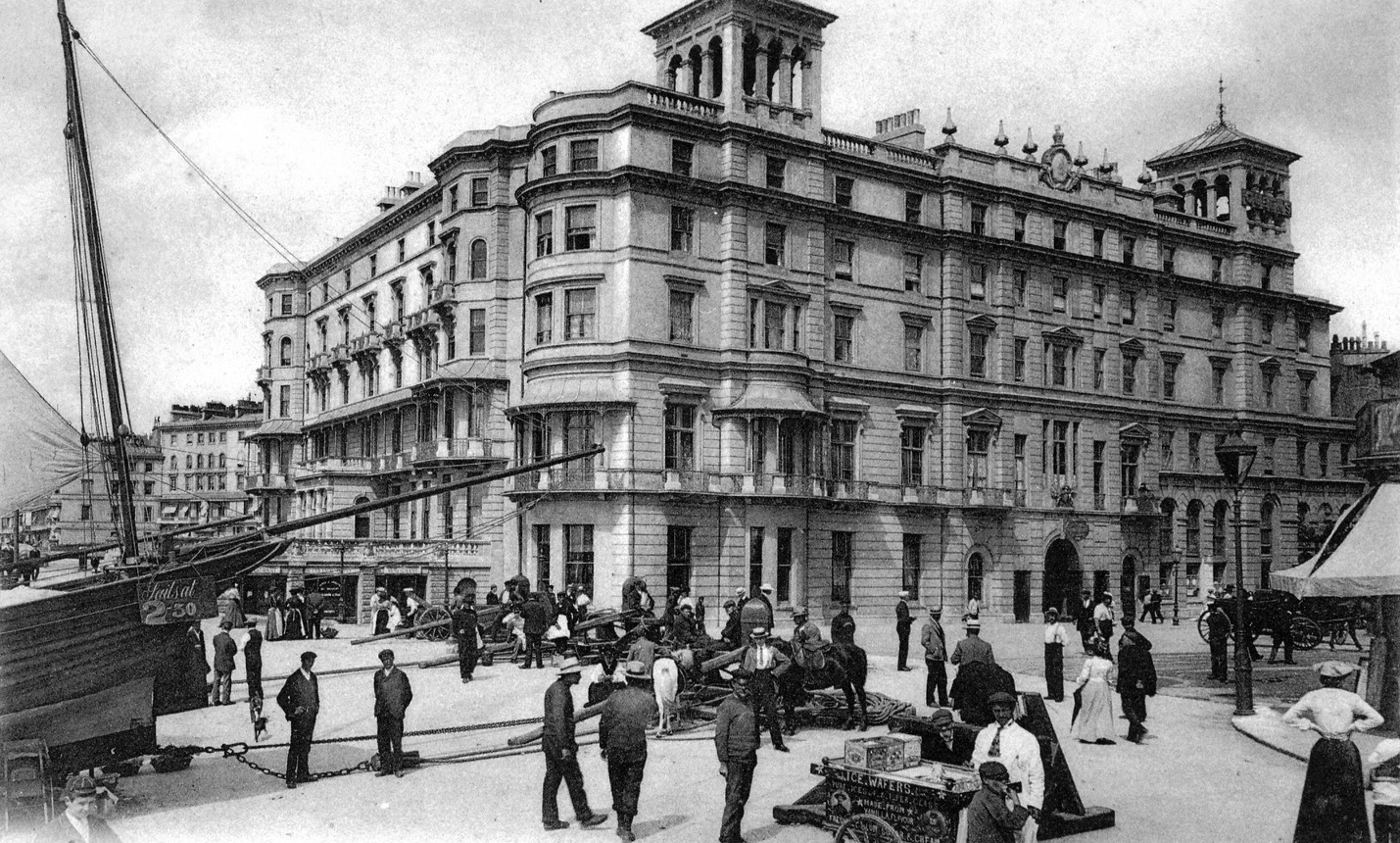
The Queen's Hotel, the biggest hotel in Hastings, seen here in the early 1900s.
1976 Mid-Jan - The Bishop of Chichester said that the 19 Anglican churches in Hastings may have to be cut by four of five over the next 10-15 years because they were not viable. Four Anglican churches had been closed since the war: St Andrew's in Queens Road, St Mary-in-the-Castle in Pelham Crescent, St Clement's at Halton and St Paul's in Church Road.
1976 Jan 23 - The popular Hastings Model Village at White Rock was wrecked by vandals. The owner of the village Stan Deboo, who had been running it for 21 years, despite repeated vandalism, said it would cost £5,000 to repair and 'it was not worth doing'. Two boys with past records, aged 12 and 13, in March admitted causing the damage. Their parents were ordered to pay £250 to Mr Deboo.
1976 Feb 24 - Hastings lifeboat saved the 14 crew of the British freighter Wittering when it collided with small German container ship Odin ten miles south of the town. Minutes after the crew of the Wittering leapt to the safety of the lifeboat the 1,598-ton ship sank. It was the biggest rescue operation by the Hastings lifeboat since the June 1952 saving of the crew of the ship Baron Douglas, which ran aground off Fairlight.
1976 March 10 - The two-year-old Saxon Mount School in Edinburgh Road was severely damaged in a major fire caused. On 15 March a 16-year-old youth was accused of starting the fire, which caused about £165,000 of devastation. The school had 84 pupils with learning difficulties.
1976 Spring - Work began on clearing the ground for the construction of the first section of the new 'spine road' that would go round the west edge of the town's expansion scheme. The initial part would link the Ridge with the Castleham Industrial Estate, at Napier Road. Battle Road was closed for two days in early August 1976 as the spine road's overhead bridge was put in place. Eleven pre-cast concrete beams, each weighing 16.5 tons, were swung above Battle Road by a giant crane. In early 1977 the Council named the road Queensway in honour of the Queen's silver jubilee that year.
1976 April 2 - The only private secretarial college in Hastings closed. The Mary Wray College at 43 Wellington Square had taught office skills since 1942, but had to close because too few people were interested in courses offered.
1976 May - Work began on implementing Lord Holford's plan for improving housing in the Old Town. It involved over the next 18 months demolishing some derelict houses between All Saints Street and Tackleway and replacing them with about dozen each of flats and houses. They would be similar to the 15 white weather-boarded houses already built off High Street.
1976 May - The well-known local building firm Eldridge and Cruttenden celebrated the centenary of its foundation in 1876 by Albert Eldridge, a painter and decorator, and Walter Cruttenden, a plumber. They played a major role in the expansion of the borough before the First World War, and had carried out much building work after 1945. The Windmill Road-based company was still run by the Cruttenden family in 1976.
1976 May 6 - In the local elections, the Tories took control in a landslide vote of what had been a hung Council. They won 20 seats, Labour 8, Liberals 4, Independent 1.
1976 May 10 - Hastings Council began spending its first significant amount on repairing the 80-year old harbour arm, filling the inner gap in the wall over the next four months with a concrete grill and 120 concrete blocks (called stabits). But this was found to be insufficient and bigger repairs were carried out in 1980. The harbour in 1976 was still ownerless; the Council acquired it early in the 1980s.
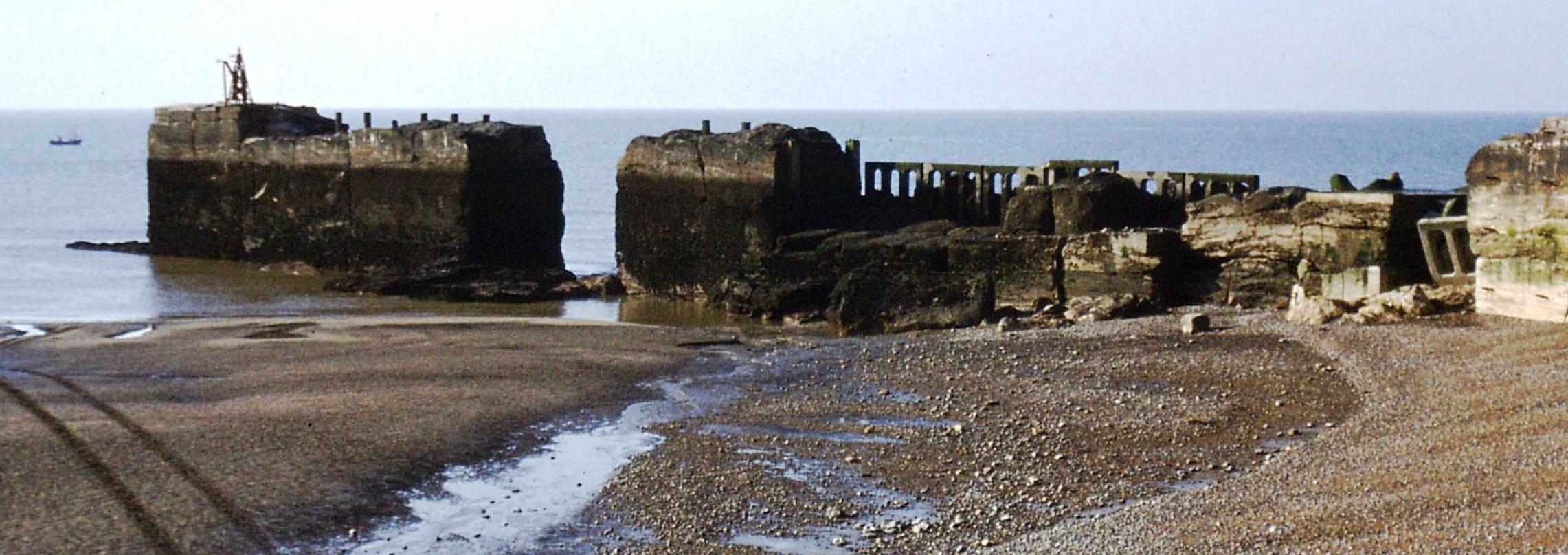
The holes in the harbour in 1984.
1976 Mid-May - It was announced that there would be no county cricket in 1976 on the Hastings Central Ground because of the poor state of the wicket.
1976 June - It was revealed that £70,000 had been spent since early 1973 trying to repair the East Hill Lift - and more work was needed. It had closed late in 1972 and since then had only worked for a few months in 1974. The system had to be almost rebuilt, including new carriages. Four men were still working on it. Eventually, after further delays, it reopened on 28 August 1976.
1976 June 24 - The 573-acre Battle Abbey estate, including the historic Battle of Hastings site, was bought by the Department of the Environment for £690,000 at an auction in London's Mayfair Hotel. The estate was sold by the Webster family, who had owned it from 1719 until 1858, and then from 1901 until this day, because of the high costs of running it.
1976 Late June - A special report by the South East England Tourist Board put the blame for the town's decline as a holiday resort squarely on the former Hastings Borough County Council and the local hotel industry. The long-awaited report condemned the complacency of the Council and criticised the hoteliers for their lack of up-to-date managerial and marketing skills. In early October 1976 the Hastings and St Leonards Hotels and Catering Association published a gloomy report based on the Tourist Board analysis. The Association said that the decline in the tourist trade was the result of neglect and lack of enterprise, and that the only route to prosperity was by skilled marketing.
1976 July - Hollington Park School, the 116-year-old independent girls school in Gillsmans Hill, closed because it was being surrounded by houses and industry, and expenses were high.
1976 July 23 - A major fire ravaged the big four-storey warehouse of TW Barnes, the scrap dealers, in George Street [its site is now Butlers Square, near the east end]. Sixty firemen with ten fire engines fought the blaze to stop it spreading in the narrow street. The street was closed to traffic for three months while preparations were made to demolish the building.
1976 Oct 5 - Negotiations for the sale of the town's two largest hotels - the 120-bed Queen's and the 100-bed Royal Victoria - were taking place, the High Court was told when a petition for the compulsory winding-up of the owners, Hastings-based Hickmet Hotels Ltd, was heard. The hearing was told the company had been in receivership for nearly two years, and creditors were owed over £9,000. But the petition was refused, as the court believed the creditors were more likely to benefit from the possible sales. In 1969 the large Victorian building had been bought, prior to auction, for £75,000 by the Gatwick Manor Hotel Ltd, whose chairman was Mr Nevvar Hickmet. In January 1977 the Queen's was put on the market for £160,000 and the Royal Victoria for £110,000. The Queens was sold on 3 January 1978 to Emma Hotels of Sevenoaks.
1976 Oct 18 - Hastings Council gave the go-ahead for a mini version of the £2.2 million sports complex plan which it had shelved in the summer because of severe spending cuts. A large swimming pool, a learner pool and a sauna would be built at Summerfields for about £1.3 million. This would include £41,000 being spent on the White Rock Baths to ensure they could remain in use until the new pools were in use. Detailed plans were given full planning permission in July 1977.
1976 Nov 10 - David Pollard, 35, of Harrow Lane, was found guilty of murdering his 31-year-old second wife Jacqueline on 10 June 1976. He had stabbed her 24 times for walking out on him eight days before then.
1976 Nov 21 - Two vandals caused £1,550 of damage to the White Rock model village. Repairs took four months. On 16 June 1977 the two local young men were jailed for leaving a trail of damage and destruction across the town, including the village, over svereal months.
1976 Dec - A poll by local schoolchildren found that 52% of local people favoured comprehensive education, 34% opposed it, and 13% didn't know. For several years Hastings Council had been resisting the national movement towards comprehensive schools, with a special determination to preserve the elitist Grammar School, in Parkstone Road. During 1977 there was a plan to build a new secondary school in the grounds of the Grammar School, but this came to nothing.
1977 mid-Jan - Mr Fred Parsons, former head of the Hastings-based newspaper group FJ Parsons Ltd, who died in November 1976, left £321,789 in his will.

The Curzon on 20 January 1977, two days before it closed.
1977 Jan 22 - The 476-seat Curzon Cinema in Norman Road closed because it was running at a loss (£6,000 in 1976). The 12 staff, who had not had a wage rise for two years, were made redundant. Its last film, shown on this day, was Raid on Entebbe. The Curzon, which had opened in November 1913, was the last cinema in St Leonards. The small 200-seat cinema Penguin in Priory Street had announced in mid-January it was closing for the rest of the winter, leaving the Orion and Classic as the only operating cinemas in the borough. The Penguin (opened 1973) and Orion were both owned by Mr Don Smith. As the Classic had a monopoly on new films, the Penguin was also a bingo hall and the Orion specialised in sex films. The Penguin never re-opened. The Curzon building was left empty for many years from 1977 before being taken over by Brookers, the builders’ merchants, who in 1986 opened a large shop and used the cinema hall for storage.
1977 Feb 28 - The new £288,000 Churchwood Primary School opened, near Hollington Church-in-the-Wood.
1977 March - Unemployment in Hastings hit a new peak in March, with 2,145 out of work, the highest number since records began in 1945. But the figures did not take into account about 80 skilled craftsmen who were about to lose their jobs with the closure of two old-established building firms in the town, Hammond Brothers of Drury Lane and Burtons of Stonefield Road.
1977 Mid-March - Shearbarn Holdiay Park in the Country Park was given the go-ahead by East Sussex County County to site 150 caravans on its big south-facing field overlooking Ecclesbourne Glen. This had widely opposed by many people, who predicted it would be a major eyesore and would damage the nature of the surrounding Country Park. The Council said that the site was very exposed, and if the field did not have an established use as a camp site for tents Shearbarn might not have been given permission.
Shearbarn and its new caravan site in the late 1970s.
1977 April - Preliminary work on building a £5 million hotel and conference Centre at High Beech in Battle Road was halted because of disagreements between Hastings Council and the developer, Mr Les Haines. The problems were never resolved and eventually former councillor Mr Haines abandoned the scheme.
1977 April 4 - The Fernbank maternity home, at 90 Old London Road, closed; cases were referred to the Buchanan Hospital in London Road.
1977 May 19 - Two all-white South African cricket teams who were scheduled to play on the Hastings Central Ground had their invitations cancelled after protests by anti-apartheid campaigners.
1977 June - The harbour arm needed further costly repairs, despite the major works carried out in the summer of 1976, said consultant engineers Sir William Helcrow and Partners. More concrete blocks (stabits) were needed to fill the gaps in the wall, at a cost of £310,000. The Council decided to seek aid from the Ministry of Agriculture.
1977 Early June - There were street parties and other events around the town to celebrate the Queen's Silver Jubilee, but many heavy showers caused problems.
1977 June 17 - Members of Refuge - a group formed to help battered women - took over a Council-owned building that was due to be demolished several days later to make way for housing. Mothers and children moved in to the former Wood End Hotel in Wishing Tree Road, but the Tory-controlled Council began immediate legal action to remove them. Labour councillor Penny Beale supported the Refuge action, which had the backing of the National Women's Aid Federation. The first court hearing, on 1 July, had many supporters inside and outside the court, but it was adjourned because of a technicality. On 8 July the five battered women and 11 children living in Wood End were given three days to get out. They were evicted on 12 July and demolition began immediately. Only two of the families were given temporary Council accommodation. Refuge was offered a lease on a five-bedroom in Seaside Road by Hastings Council, but after long delays in Refuge making a decision, and then changing their minds on the lease, the Council withdrew the offer in late June 1978.
1977 July 4 - A 14ft 6 inch tall double-decker bus had its roof sliced off when it was driven (unsuccessfully) under the 12ft 9 inch railway bridge in Braybrooke Road.
1977 July 7 - The last four Hastings aircraft in service with the RAF were retired. They had entered service in 1946 and had taken part in the 1948 Berlin airlift. All four were to be preserved.
1977 Mid-July - The 73-bedroom Alexandra Hotel in Eversfield Place was bought by Senor Maiz, a Spanish businessman who had recently bought the Convent of the Holy Child in Magdalen Road. The hotel had closed for repairs in December 1973 after the Hickmet Hotel group, of which the Queen's and Royal Victoria Hotels were part, went into receivership in August 1974. It was the first of the three to be sold.
1977 July 20 - The town’s tallest office block, the 12-storey Gundolphus House in London Road overlooking Warrior Square Station, was opened. Described by critics as monstrous and ugly, it was the south east regional headquarters of the government’s Property Services Agency which was responsible for the design of official buildings. The 270 staff transferred from the Department of the Environment's National Computer Centre at Ashdown House. It took three years to build, on the site of the Regal Cinema which was demolished in 1973. It was named after Gundulf (Gundolphus) who came to England after the Norman Conquest and was commissioned by King William to build the White Tower of London.

The old Priory Road fire station being demolished in February 1993.
1977 July 20 - Hastings fire officers moved into their new £256,000 fire station on the Ridge. The new two-storey building had a tower, full accommodation and bays for three appliances. It was to be manned 24 hours-a-day by three nine-officer shifts. It replaced the Halton fire station on Priory Road, which had covered eastern Hastings and nearby villages. Halton was officially opened in November 1879. During the Second World War the station was enlarged and engines were sent to London and other cities to help in bombing raids. From July 1977 it was taken over by the adjoining Priory Road School, and was demolished in early 1993.
1977 July 25 - The GLC tried (not convincingly) to reassure Hastings Council that it would not be pulling out of the 1969 town expansion scheme. Already £10-£12 million had been spent by Hastings Council, East Sussex County Council and the GLC, but over 70 houses were standing empty and few factories had moved to the new Castleham Industrial estate. Already one part of the scheme - the 562-house Little Ridge Farm area - had been axed. The expansion was running considerably slower than hoped, and the GLC had been trying to discourage businesses from leaving London.
1977 July 28 - One of Britain's two remaining Meteor jets was put on permanent display on a stand outside St Leonards Motors garage on the corner of Bexhill Road and West Hill Road. Built in 1952, it had a 32-foot wingspan. It was owned by St Leonards Motors, which moved to new a HQ in Churchwood Drive in the mid-1980s and relocated the Meteor there. In mid-2012 it was returned to original birthplace of Gloucester for much-needed restoration, where it remained.
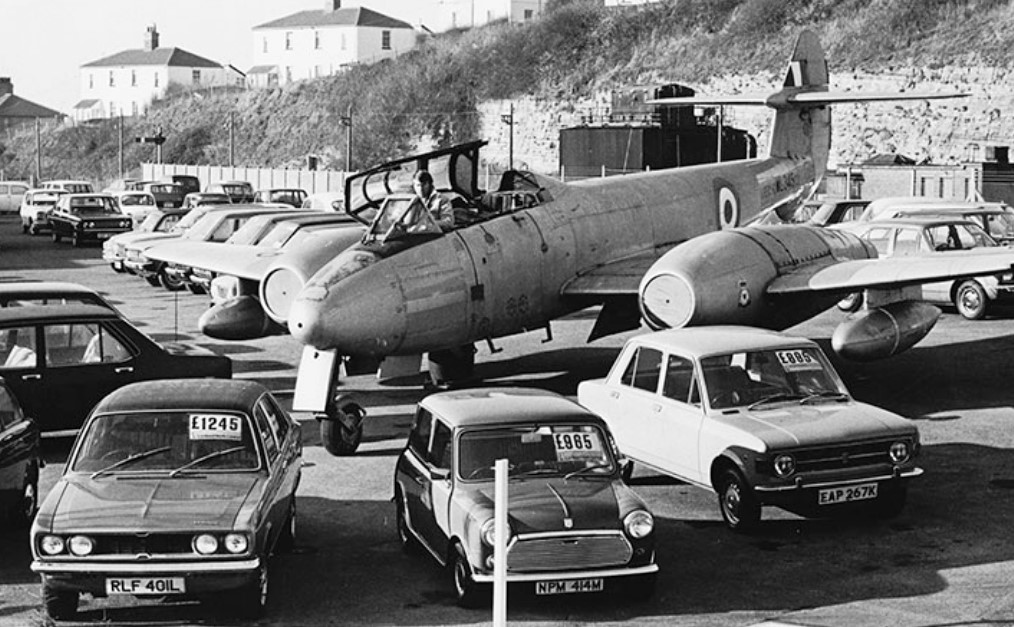
The Meteor landing in Bexhill Road.
1977 Early Aug - A Claimants Union was formed to help people claiming state benefits to get their full rights.
1977 Aug 13 - Over 8,000 people flocked to Hastings Council's first Town and Country Fair in Alexandra Park. The fair combined the town's summer and autumn flower shows with fairground entertainments, exhibitions and arena events. Ir remained a popular annual event into the mid-1980s, but it fizzled out because of poor management by Council officers.
1977 Sept 1- The new Isabel Blackman Day Centre for elderly people opened in Winding Street in the Old Town. It offered a full range of facilities, including bathing, hair-washing and ready meals. It was on the site of the Bourne public baths and wash-house which had been set up by Countess Waldegrave in 1865. The Day Centre was run by East Sussex County Council, which closed it in March 2019 as part of an economy drive.
1977 Sept 9 - The first half of Queensway, the town's £750,000 new spine road linking the Ridge and Napier Road, was officially opened. The second half would link Napier Road with Crowhurst Road. Also this week the County Council gave the preliminary go-ahead for Queensway to be extended from Crowhurst Road to the junction of Harley Shute Road and Ironlatch Avenue. These new roads were part of the town's expansion scheme, backed by the GLC, over which there was still great uncertainty. It had been agreed in 1971 that the GLC would build about 5,700 homes, but so far they had only completed 400. The GLC had also projected the creation of 7,000 new jobs, but only 480 had been created.
1977 Sept 27 - Jooks café and disco at the bottom of the High Street was destroyed by a massive fire. The three-storey building, known as the Hi-Fi, had been run for seven years as a disco and cafe, but was then empty and up for sale. The site of the building is still vacant.
1977 Oct 5 - The result of a ballot of Hastings parents on the future of the education system in the town was announced at a special meeting of the county council's schools sub-committee. Less than half the 6,300 eligible families voted. They voted 1,749 in favour of keeping the selective system, with 1,336 against. But the sub-committee ignored the vote, and voted for the comprehensive system. The county education committee agreed, and voted to implement the scheme from September 1978, but the county council decided to delay it for further consideration. In January 1978 it was announced that the Grammar School would be just for boys and the High School and Maplehurst for girls, and the Grove School and Hillcrest School would both be re-organised as mixed.
1977 Oct 12 - A group of important buildings at the bottom of Cambridge Road, including WH Smiths, the Orion Cinema and the York and Crypt Bars, were put up sale at an auction in the Queens Hotel. Bidding reached £235,000, but this was below the reserve price of £240,000. The buildings changed hands privately a few days later. Until then they had been owned by the locally-owned Central Assembly Room and Arcade Company, which had built the properties in 1859. In January 1978 the new owners, Marcope Properties, announced that the Orion Cinema on the upper floor would be converted into shopping units when its lease ran out that September. What was WH Smiths is now the Yates pub.
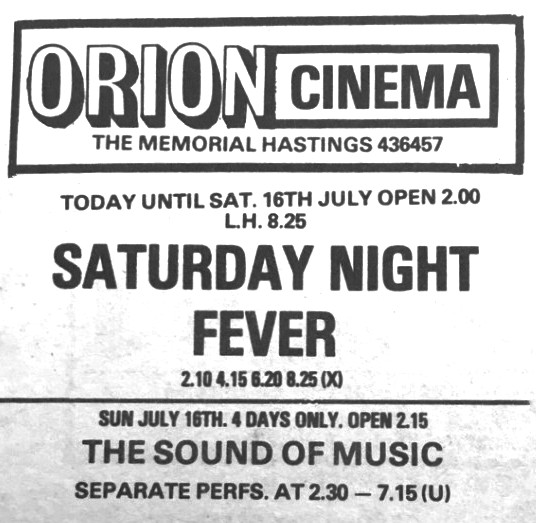
On show at the Orion, 16 July 1977.
1977 Oct 19 - Hastings Council decided to demolish the former Hollington Junior School, despite a widespread campaign by local residents to turn it into a 'do-it-yourself' community centre.
1977 Early Nov - Members of the National Graphical Association (NGA) working at the Observer began a dispute with management about overtime payments. They went on strike, causing the management to reduce the size of published editions, until losing the issues of November 26 and December 3. In early December a settlement was agreed, and publication resumed on December 10.
1977 Nov 14 - Hastings firemen went on strike in support of a national 30% pay claim. The Army arrived in town with two 'Green Goddesses' - 25-year-old civil defence vehicles - each manned by about a dozen members of the 9th Parachute Squadron, Royal Engineers. They were based at the Territorial Army HQ in Cinque Ports Way. There was much public support for the strike. The firemen returned to work on 9 January when the government gave a 10% pay rise and other benefits.
1977 Mid-Nov - The old Hollington Junior School was demolished to make way for houses, despite many protests.
1977 Early Dec - The 70-bedroom Marlborough Hotel in Warrior Square was sold, 11 months after the receiver was called in. It had a 180-seat dining room, a concert room, a lounge bar and three lounges. The buyers intended to keep running it.
1977 Early Dec - A record number of unemployed people in Hastings was reported: 2,298 in November.
1977 Mid-Dec - Hastings Council lodged a claim for £112,000 from the designer of the municipal golf course at Beauport. The £200,000 course opened in early 1973 and had suffered repeated problems from big drainage problems and overall poor design by architect Mr Frank Penning, the subject of the claim. It was referred to arbitration, and in April 1979 the settlement gave the Council just £9,000. But in mid-August 1979 the jinx struck again when serious cracks appeared in the six-year old clubhouse. There was movement in the building and it had to be shored up while a £2,000 survey of the damage was carried out. In late July 1980 the survey said the south and west walls should be demolished and replaced, and other works were needed. This would cost another £50,000, on top of the £73,000 already spent.
1978 Jan 3 - The Queens Hotel was sold to the Emma Hotel group. Its owner, Mr Ronald Powe of Dunton Green near Sevenoaks, said he would be spending about £300,000 on turning the Queens into a 'showplace of the south', with a first class casino and top flight cabaret stars. Its previous owners, Hickmet Hotels, had been in receivership for three and a half years.
1978 Late Jan - The Combe Haven Caravan Park was sold to a subsidiary of the giant English China Clays Group in a £1.57 million package deal involving two other holiday parks. The new owner of the 62-acre site, with 900 caravans and chalets, plus a big entertainments centre, was Haven Leisure.
1978 Feb - The beach at the foot of Fairlight Glen was wrongly declared to be an ‘official naturist beach’, starting an ongoing problem of offensive behaviour by naked men which continues today.
1978 Feb 10 - The town's second largest hotel - the Royal Victoria - was sold after nearly four years in receivership. This meant that all the town's major hotels were back in business, on an independent basis. The 73-bedroom hotel had been bought by Mr Hirdo Patel, who did not disclose how much he paid, although it had been on the market at £110,000.
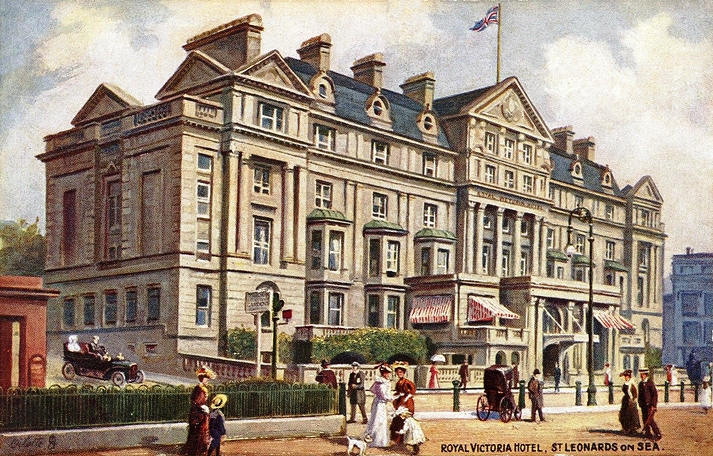
The Royal Victoria Hotel before the First World War.
1978 Late Feb - A record number of unemployed people in Hastings was reported: 2,460 in February.
1978 Early March - Hastings Council's development committee gave the go-ahead for the demolition of Scrivens Buildings in Crown Lane. The block of 23 unoccupied flats, a notorious eyesore, was one of the first to be built of reinforced concrete, in 1873. There were communal lavatories, no baths and only a few had hot water.
1978 March 29 - A year-long investigation by Hastings Council's Personnel Officer reported that the Council's catering management was 'inept, naive and archaic'. Under investigation were the three main Council-run catering establishments - the Falaise Hall, the White Rock Pavilion and the Sun Lounge - plus the general administration and the stores. The managers and their command structure were condemned. The Observer said that the 'damning indictment' read 'like a script for an anarchic television comedy'.
1978 April 24 - The Waverley, the last seagoing paddle steamer in the world, took over 800 passengers on a four-hour excursion from Hastings Pier.
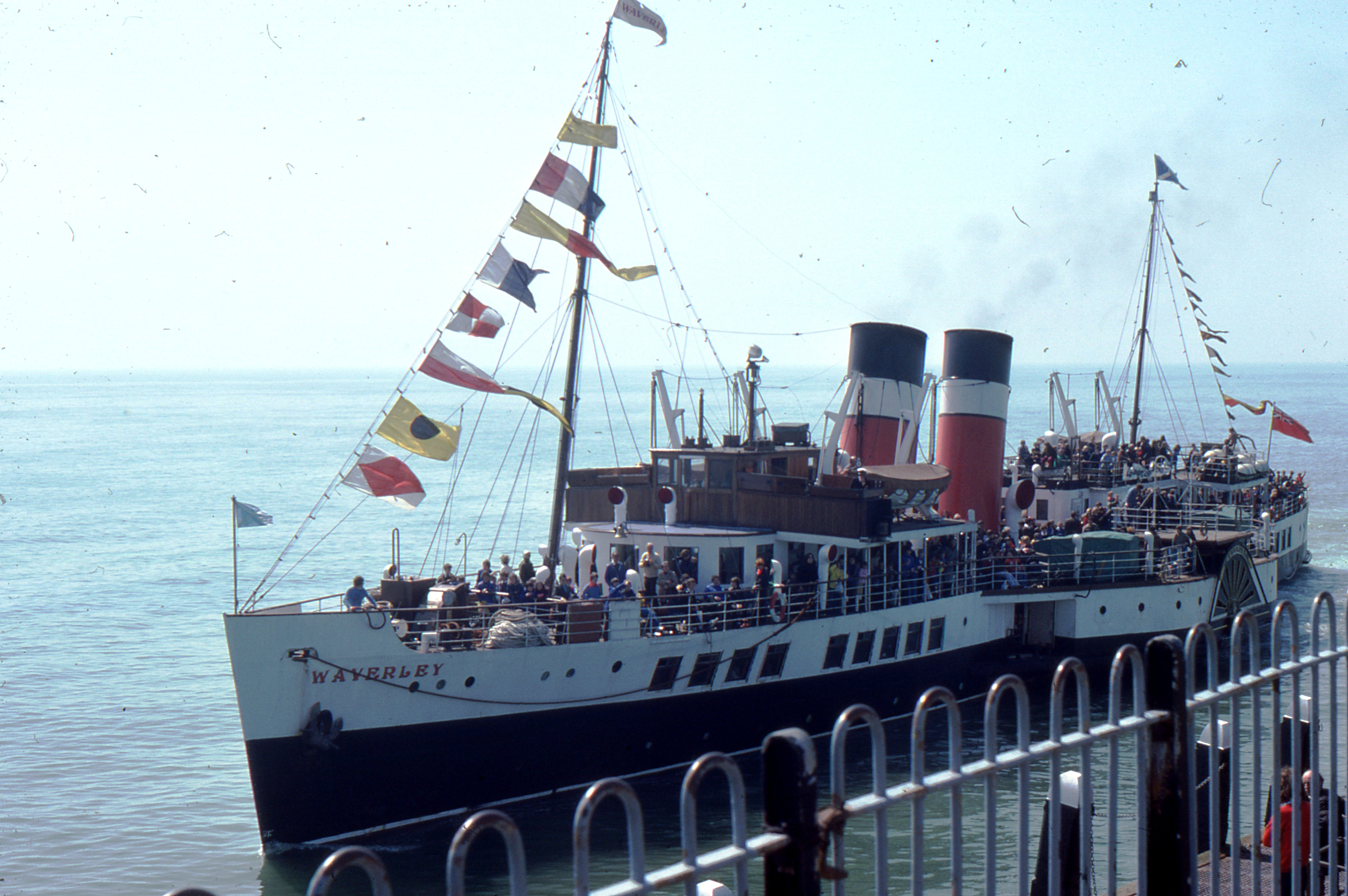
The Waverley at the pier.
1978 April 25 - The mayor Cllr John Hodges took controls of a giant bulldozer to start work on building the town's first major sports complex, at Summerfields. The likely cost had risen to £1.75 million.
1978 May 26 - The loss of major printing contracts worth £347,000, following industrial disputes and disruptions, had led to 33 people losing their jobs at FJ Parsons Ltd, owners of the Hastings Observer, managing director Brian Nicklin announced. And he feared a complete closure of the printing section - with the loss of another 125 jobs - if further disputes affected production. Eight contracts representing 39% of the general printing department's turnover were lost following a two-week stoppage in December 1977. But production of the Observer and other weekly newspapers was halted after the July 1 edition in a four week dispute with the National Graphical Association (NGA) over who would be made redundant after the announcement the job losses. The Observer next appeared on August 5, with the company saying its losses had 'reached a sum well into six figures'.
1978 June 14 - The Queen Mother paid a six-hour visit to the town. She arrived at 11.30 by helicopter on the Oval and opened the new St Leonards Church of England Primary School.
1978 July 1 - Despite much local opposition, the Registrar of Friendly Societies gave the go-ahead for a merger of the £554 million Hastings and Thanet Building Society and the £771 million Anglia Building Society on this day. The £1 billion merger created the 7th biggest building society in the country. The Hastings and Thanet was created in 1849 as the Hastings Permanent, since when it had gone through 33 mergers, including the 1951 merger with the Isle of Thanet. By late 1977 it had more than 90 branches throughout the country.
1978 Aug - A free local radical news magazine called Poison Pen was started by Michael Bloxham. He ran the Solstice Book in Bohemia Road. In December 1979 Mr Bloxham, plus Keith Rodway and former Labour councillor Penny Beale, were sued for libel by the deputy mayor, Labour councillor Jack Cook for claims about his attitude to migrants. Cllr Cook won the case on 1 April 1980 and they were ordered to pay his costs of many hundreds of pounds.
1978 Aug 8 - A massive fire caused £75,000 of damage to Fads Homecare Centre in Queens Road. In July 1979 a 14-year old St Leonards boy was accused of arson. Stock worth £35,000 had been destroyed and £40,000 of damage had been caused to the building. It was on the corner of South Terrace, and was the same building in 1938 - then named Dengate's - where there had been a similar disastrous fire.
1978 Aug 26 - The smaller of the two White Rock Baths re-opened as the town's first indoor skateboard park. But by September 1979 the skateboard craze was dying out, and the renters - Dave and Harry Beedon - applied for permission from the Council to turn the premises into a music and dance hall. This was refused, however.
1978 Aug 30 - An experienced Yorkshire-based development company held a meeting with senior councillors and Council officers to discuss its plan to build a multi-million pound shopping centre on the Central Cricket Ground. Informal meetings had taken place in June and August. A protest group wanting to preserve the cricket ground was formed, and on 13 November 86-year old Lord Cornwallis, whose father sold the land to the cricket ground trust, gave a speech opposing the proposal to over 400 people at the White Rock Pavilion. In March 1979 the Department of the Environment refused to allow Hastings Council to compulsory purchase the cricket ground, and the proposal came to nothing, but it was the first time that such a plan had been put forward.
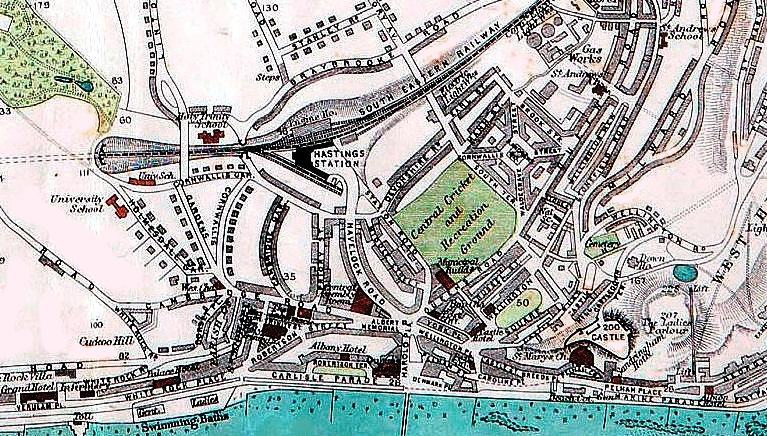
The town centre in 1900.
1978 Aug 31 - The Orion Cinema in Robertson Street showed its last film, Star Wars. There had been a cinema on the first floor of 54-55 Robertson Street since 1913, in what until then was the Public Hall, built in 1859. The booksellers and stationers WM Smith, which had occupied the ground floor since c1936, took over the whole building on 1 September 1978. This left the Classic in Queens Road as the borough’s only remaining cinema. Nos 53-55 Robertson Street are now Yates’s Wine Lodge.
1978 Sept - A B&Q DIY Supercentre opened in Rye Road. At 17,000 square feet it was the largest DIY centre in the Hastings area. The B&Q Supercentre chain began life in 1969 when modest premises opened in Southampton. Hastings was the 22nd branch.
1978 Sept 1 - The comprehensive education system began in Hastings, with its five secondary schools reduced to four. The boys-only William Parker School was formed by the merger of Hastings Grammar School and Priory Road Secondary School. Its Parkstone Road building had been the Grammar School until then. The Priory Road buildings stayed in use. The girls-only High School was renamed Helenswood. The Grove and Hillcrest retained their names and became co-educational.
1978 Oct 17 - The famous St Leonards-based clock manufacturers Thwaites and Reed was sold for £78,300, just 20 months after being acquired by government-backed National Enterprise Board for £240,000. In 1977 the company had repaired Big Ben, but it was suffering financial problems, and had been laying off staff, rather than recruiting more. The NEB lost £450 of public money in the investment, which critics said should never have happened. In January 1979 Thwaites and Reed lost the right to use the Royal Warrant.
1978 Dec 5 - The County Council gave outline planning permission for a sports and leisure centre to be built on the 5.7 acre site of the former Hastings Gas Works at Glyne Gap. The applicant was the Bexhill Chamber of Commerce. But nothing came of the proposal. Also this week a London development company submitted a plan to Hastings Council's tourism committee proposing that they build a large-scale holiday and housing development on the site of the Bathing Pool at Seaside Road. This also never came to fruition.
1978 Dec 15 - Parents of the 70 pupils at Ledsham Court boarding and day school for girls, on the Ridge near the cemetery, are told suddenly that the school had closed because of the ill-health of the principal, Mrs Winifred Redfarn.
1979 Jan + Feb - Hastings was hit hard by the widespread national industrial disputes. There were strikes in many public services, plus lorry drivers, building workers and train drivers.
1979 Jan 1 - Seven inches of snow and temperatures of minus seven degrees centigrade brought the coldest week for years.
1979 Mid-Jan - A blocked drain at the abattoir on the Ridge caused major pollution of Hollington Stream, which ran red with the blood of slaughtered animals.
1979 Mid-Feb - Work began on building the giant Tesco shopping centre at Churchwood Drive. Tesco was currently in the town centre, at the south-west corner of Wellington Square.
1979 Feb 17 - Tons of rock falling onto the Yelton Hotel from the cliff behind caused much damage, wrecking one room completely. [The Yelton is now the White Rock Hotel, and since 1979 there have been several rock falls onto buildings between the hotel and Robertson street.] On 18 March 1979 100 tons of earth collapsed against the side of St Leonards Parish Church. It slipped down the cliff face below West Hill Road, exposing grave stones from the old churchyard on top of the cliff.
1979 March 12 - A new political organisation, HASIC - the Hastings and St Leonards Association for the Support of Independent Candidates - was born at a meeting in the Chatsworth Hotel.
1979 April - Hospital Radio Hastings began broadcasting live to all major local in the Hastings/Bexhill area. It had started broadcasting in 1975 for just the Royal East Sussex Hospital, operating from a virtual cupboard. The service was set up and run entirely by volunteers, who were making this expansion possible.
1979 April 2 - Council house rents rose by a massive 27%, despite opposition from Labour and Liberal councillors. Domestic rates went up 14%.
1979 April 5 - Hastings Council announced a multi-million pound go-it-alone town development scheme following negotiations with the GLC. The GLC had embarked on a joint development with the Council in 1969, planning to provide jobs and houses for 18,000 Londoners in the town. A major housing project at Tile Kiln and the Castleham Industrial Estate were begun, but in 1976 the GLC pulled out of the scheme and there were fears that an economic recession would result. The Council believed that this new, highly-complicated scheme 'could ensure economic recovery and future well-being' for the town.
1979 April 14 - More than 2,000 motor bikers descended on the town from all over Britain in protest at the law forcing bikers to wear helmets. They came to a rally organised by the Motor Cycle Action Group. On July 3 sixty-one bikers were fined a total of £470, mainly for not wearing helmets.
1979 April 28 - The big new clubhouse of the Hastings and St Leonards Angling Association opened. Located next to the west side of the Old Town boating lake, it had cost £60,000 and had a bar, cafe and social room.
1979 May 3 - There was a general election and council elections on the same day. The Tories under Margaret Thatcher won the general election, removing Labour, and Hastings Tory MP Kenneth Warren was returned with the town's biggest majority for nearly 30 years - 8,919. The town had had only Tory MPs since 1906. In the local elections, the Tories lost control, with three top Tories losing their seats in a massive 67% poll, the biggest-ever turn-out for a town hall vote. The Tories won 16 seats, Labour eight, Liberals seven and one independent. But in late May the Tories gained the chairmanships of seven out of eight of the Council committees. In the European Parliament elections on June 7, only 29% of the town's electorate voted.
1979 June 1 - The Secretary of State for the Environment backed Hastings Council's refusal to allow greyhound racing on the Pilot Field, Hastings United's stadium in Elphinstone Road. Local residents had opposed the scheme because of the likely noise and disturbance, already bad enough with the football matches.
1979 June 9 - Rampaging Mods left a £4,000 trail of damage to local shops. After leaving a concert on the pier at 11.30, about 200 Mods charged through Robertson Street, chanting, shouting and smashing windows. Four youths were charged after the town's worst vandalism for years.
1979 June 23 - In what was believed to be the first event of its kind in the town, about 200 gay men and women held a disco night in the Council-owned Falaise Hall. They were celebrating the start of Gay Pride Week, which culminated with a Carnival Parade in London on June 30.
1979 Aug - Remnants of the old St Leonards Pier were uncovered by shingle movement. Four steel members of the structure, in very good condition, were removed by the Council because they were a hazard to the public.
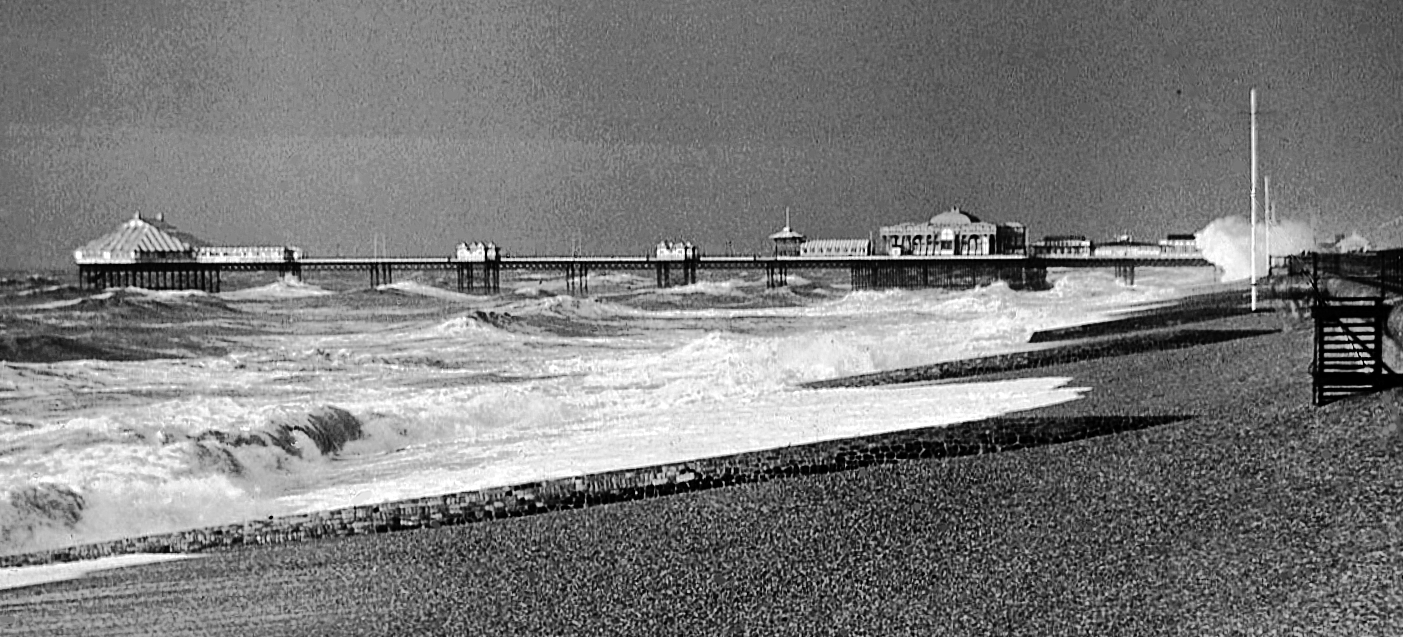
St Leonards Pier in the 1930s.
1979 Aug 2 - Woods Construction, one of the town's leading building firms, went into receivership. The company's HQ, the large Woods House in Telford Road, was up for sale. Combined net losses for 1977/78 and 1978/79 amounted to £388,000 and the company had a £577,000 overdraft. Forty staff were made redundant. The company was wound up on 2 December 1979, with 400 unsecured creditors owed about £700,000.
1979 Sept 29 - The town’s biggest private employer, ITT Consumer Products, which was making radios and TVs on the Ponswood estate, announced it was to close by June 1980 with the loss of 650 jobs. It had come to Hastings in 1960 as Kolster Brandes. At the peak of its production, in the mid-1970s, nearly 1,200 people were employed at the factory. The headquarters was in New York.
1979 Early Oct - The rail line from Ore to Ashford was converted to single-track use as an economy measure. The unused track was removed later.
1979 Oct 13 - A protest march against nuclear power took place. Supported by Friends of the Earth, the Ecology Party and Hastings Anarchists, the protesters went from the Old Town to the town centre. They were especially concerned about plans to build a third nuclear power station at Dungeness. The Hastings Anti-Nuclear Group was created in November. They then tried to have a stall in the town centre on Saturdays, but on 1 December the police confiscated their literature.
1979 Nov - The Regional Health Authority gave the go-ahead for a new district general hospital to be built on a 40-acre farm site on the Ridge. This was to become today’s Conquest Hospital.
1979 Late Nov - Work began on dismantling the massive Victorian gas holders in Queens Road, plus surround boiler houses and ancillary huts. The four gasholders were built between 1887 and 1901, and had not been used since 1974. Morrisons Supermarket is now on the site.
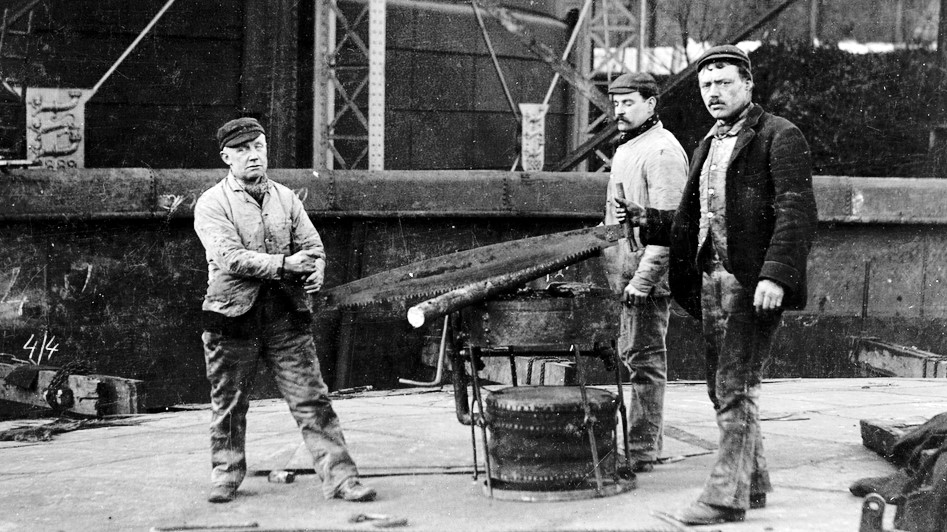
Building the Queens Road gas holders in the late 19th century.

